The extent, variability, and attitudes towards volunteering among undergraduate nursing students: Implications for pedagogy in nursing and midwifery education
VerifiedAdded on 2023/06/05
|39
|9146
|52
AI Summary
This article discusses the benefits of volunteering for nursing students, including increased exposure to diverse environments, improved critical thinking skills, and enhanced self-confidence. The study aims to understand the extent, variability, and attitudes towards volunteering among nursing students and make recommendations for the nursing curriculum. The article highlights the importance of embedding volunteering within academic programs and structured learning events to teach care and compassion to nursing students.
Contribute Materials
Your contribution can guide someone’s learning journey. Share your
documents today.
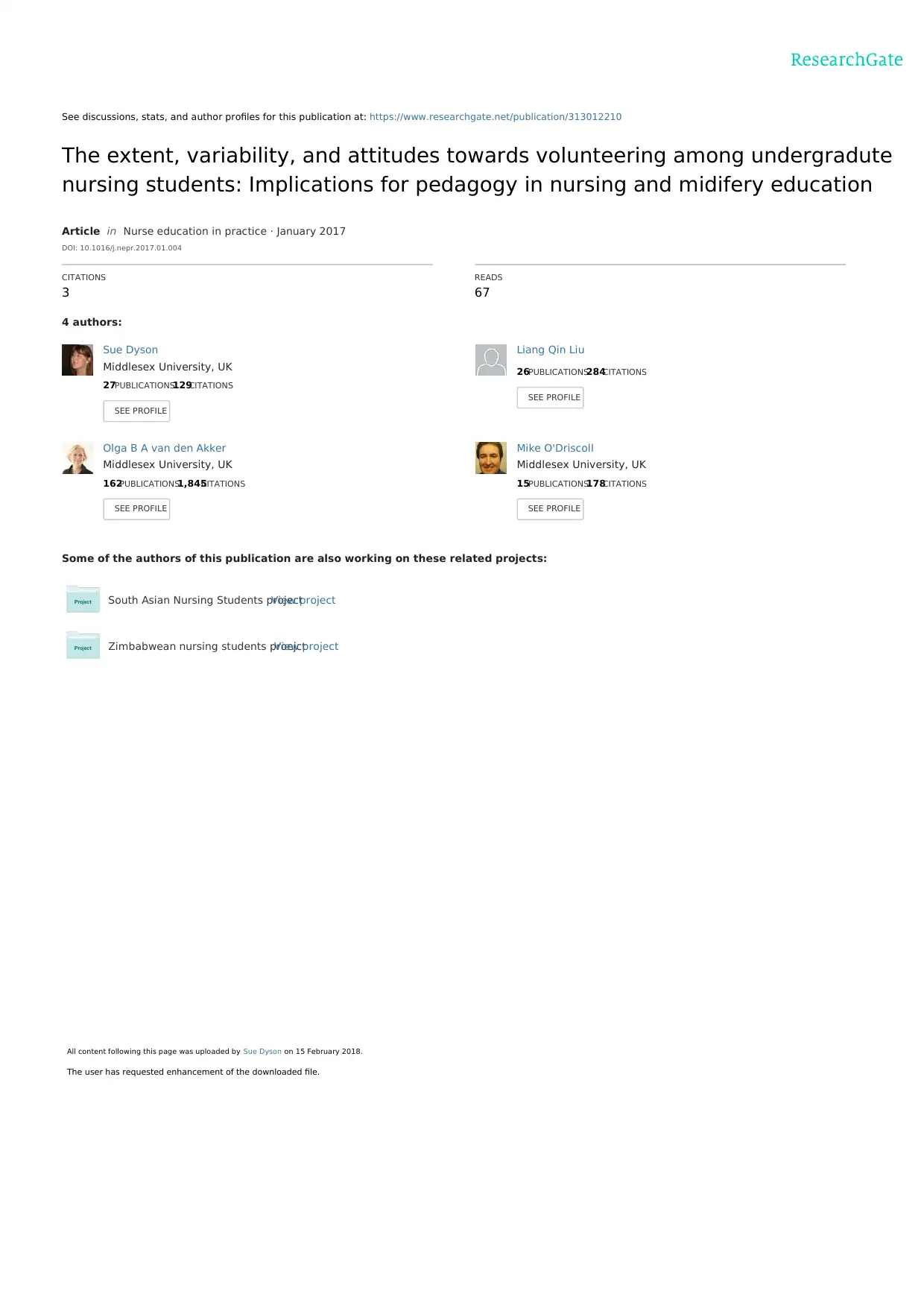
See discussions, stats, and author profiles for this publication at: https://www.researchgate.net/publication/313012210
The extent, variability, and attitudes towards volunteering among undergradute
nursing students: Implications for pedagogy in nursing and midifery education
Article in Nurse education in practice · January 2017
DOI: 10.1016/j.nepr.2017.01.004
CITATIONS
3
READS
67
4 authors:
Some of the authors of this publication are also working on these related projects:
South Asian Nursing Students projectView project
Zimbabwean nursing students proejctView project
Sue Dyson
Middlesex University, UK
27PUBLICATIONS129CITATIONS
SEE PROFILE
Liang Qin Liu
26PUBLICATIONS284CITATIONS
SEE PROFILE
Olga B A van den Akker
Middlesex University, UK
162PUBLICATIONS1,845CITATIONS
SEE PROFILE
Mike O'Driscoll
Middlesex University, UK
15PUBLICATIONS178CITATIONS
SEE PROFILE
All content following this page was uploaded by Sue Dyson on 15 February 2018.
The user has requested enhancement of the downloaded file.
The extent, variability, and attitudes towards volunteering among undergradute
nursing students: Implications for pedagogy in nursing and midifery education
Article in Nurse education in practice · January 2017
DOI: 10.1016/j.nepr.2017.01.004
CITATIONS
3
READS
67
4 authors:
Some of the authors of this publication are also working on these related projects:
South Asian Nursing Students projectView project
Zimbabwean nursing students proejctView project
Sue Dyson
Middlesex University, UK
27PUBLICATIONS129CITATIONS
SEE PROFILE
Liang Qin Liu
26PUBLICATIONS284CITATIONS
SEE PROFILE
Olga B A van den Akker
Middlesex University, UK
162PUBLICATIONS1,845CITATIONS
SEE PROFILE
Mike O'Driscoll
Middlesex University, UK
15PUBLICATIONS178CITATIONS
SEE PROFILE
All content following this page was uploaded by Sue Dyson on 15 February 2018.
The user has requested enhancement of the downloaded file.
Secure Best Marks with AI Grader
Need help grading? Try our AI Grader for instant feedback on your assignments.
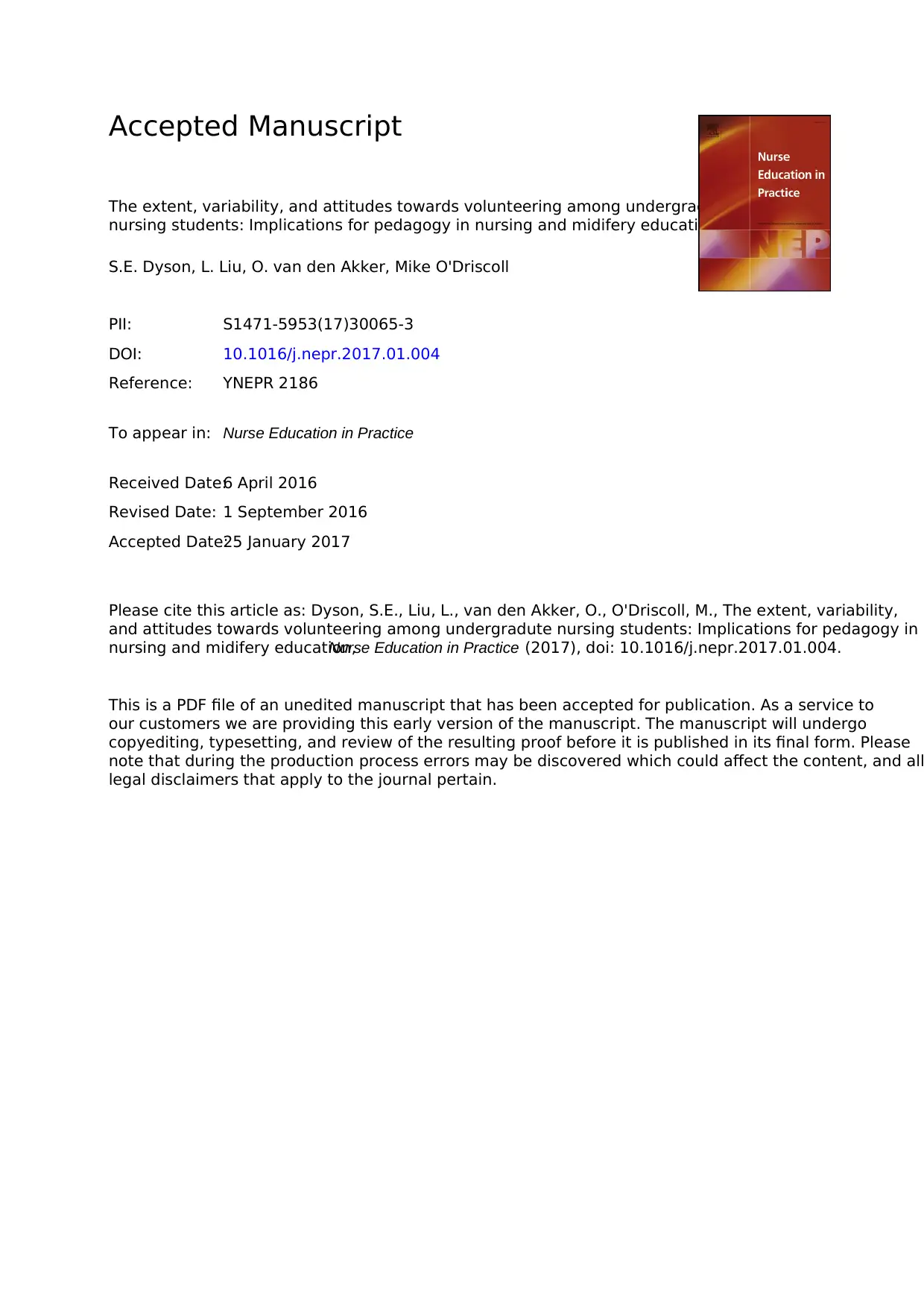
Accepted Manuscript
The extent, variability, and attitudes towards volunteering among undergradute
nursing students: Implications for pedagogy in nursing and midifery education
S.E. Dyson, L. Liu, O. van den Akker, Mike O'Driscoll
PII: S1471-5953(17)30065-3
DOI: 10.1016/j.nepr.2017.01.004
Reference: YNEPR 2186
To appear in: Nurse Education in Practice
Received Date:6 April 2016
Revised Date: 1 September 2016
Accepted Date:25 January 2017
Please cite this article as: Dyson, S.E., Liu, L., van den Akker, O., O'Driscoll, M., The extent, variability,
and attitudes towards volunteering among undergradute nursing students: Implications for pedagogy in
nursing and midifery education,Nurse Education in Practice (2017), doi: 10.1016/j.nepr.2017.01.004.
This is a PDF file of an unedited manuscript that has been accepted for publication. As a service to
our customers we are providing this early version of the manuscript. The manuscript will undergo
copyediting, typesetting, and review of the resulting proof before it is published in its final form. Please
note that during the production process errors may be discovered which could affect the content, and all
legal disclaimers that apply to the journal pertain.
The extent, variability, and attitudes towards volunteering among undergradute
nursing students: Implications for pedagogy in nursing and midifery education
S.E. Dyson, L. Liu, O. van den Akker, Mike O'Driscoll
PII: S1471-5953(17)30065-3
DOI: 10.1016/j.nepr.2017.01.004
Reference: YNEPR 2186
To appear in: Nurse Education in Practice
Received Date:6 April 2016
Revised Date: 1 September 2016
Accepted Date:25 January 2017
Please cite this article as: Dyson, S.E., Liu, L., van den Akker, O., O'Driscoll, M., The extent, variability,
and attitudes towards volunteering among undergradute nursing students: Implications for pedagogy in
nursing and midifery education,Nurse Education in Practice (2017), doi: 10.1016/j.nepr.2017.01.004.
This is a PDF file of an unedited manuscript that has been accepted for publication. As a service to
our customers we are providing this early version of the manuscript. The manuscript will undergo
copyediting, typesetting, and review of the resulting proof before it is published in its final form. Please
note that during the production process errors may be discovered which could affect the content, and all
legal disclaimers that apply to the journal pertain.

MANUSCRIPTACCEPTED
ACCEPTED MANUSCRIPT
Title page
THE EXTENT, VARIABILITY, AND ATTITUDES TOWARDS VOLUNTEERING AMONG
UNDERGRADUTE NURSING STUDENTS: IMPLICATIONS FOR PEDAGOGY IN NURSING
AND MIDIFERY EDUCATION.
Dyson, S.E, Liu, L and van den Akker, O
Corresponding author: Professor Sue Dyson
Professor Sue Dyson1
1Middlesex University
School of Health and Education
Room WG 17, Williams Building
The Burroughs
Hendon
London NW4 4BT
Tel: +44 (0) 20 8411 2887
Email: s.dyson@mdx.ac.uk
Dr Liang Liu2
2Middlesex University
School of Health and Education
Room WG 17, Williams Building
The Burroughs
Hendon
London NW4 4BT
Tel: +44 (0) 20 8411 2893
Email: L.Q.Liu@mdx.ac.uk
Mike O’Driscoll3
3Middlesex University
School of Health and Education
Room WG 17, Williams Building
The Burroughs
Hendon
London NW4 4BT
Email: m.odriscoll@mdx.ac.uk
ACCEPTED MANUSCRIPT
Title page
THE EXTENT, VARIABILITY, AND ATTITUDES TOWARDS VOLUNTEERING AMONG
UNDERGRADUTE NURSING STUDENTS: IMPLICATIONS FOR PEDAGOGY IN NURSING
AND MIDIFERY EDUCATION.
Dyson, S.E, Liu, L and van den Akker, O
Corresponding author: Professor Sue Dyson
Professor Sue Dyson1
1Middlesex University
School of Health and Education
Room WG 17, Williams Building
The Burroughs
Hendon
London NW4 4BT
Tel: +44 (0) 20 8411 2887
Email: s.dyson@mdx.ac.uk
Dr Liang Liu2
2Middlesex University
School of Health and Education
Room WG 17, Williams Building
The Burroughs
Hendon
London NW4 4BT
Tel: +44 (0) 20 8411 2893
Email: L.Q.Liu@mdx.ac.uk
Mike O’Driscoll3
3Middlesex University
School of Health and Education
Room WG 17, Williams Building
The Burroughs
Hendon
London NW4 4BT
Email: m.odriscoll@mdx.ac.uk
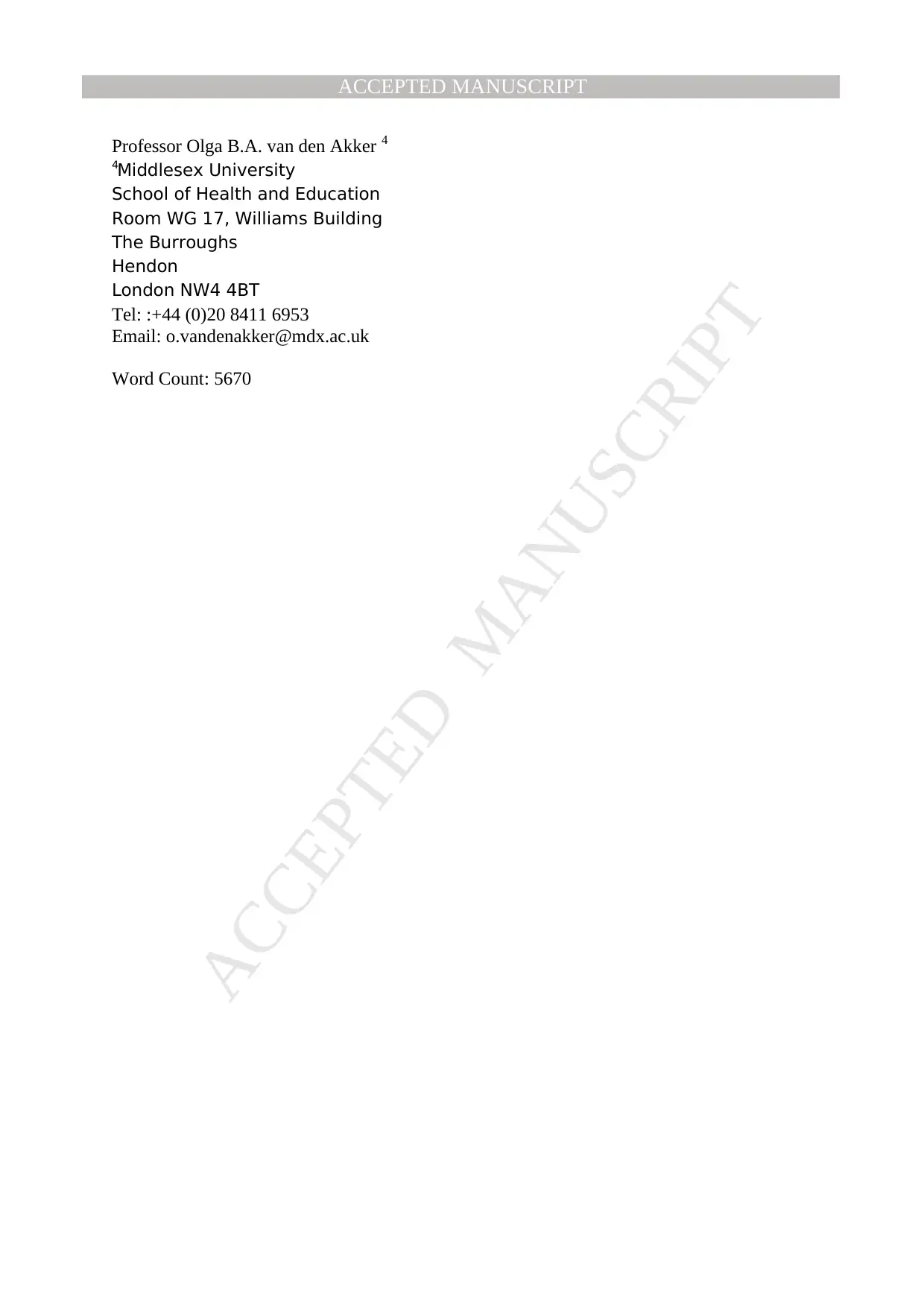
MANUSCRIPTACCEPTED
ACCEPTED MANUSCRIPT
Professor Olga B.A. van den Akker 4
4Middlesex University
School of Health and Education
Room WG 17, Williams Building
The Burroughs
Hendon
London NW4 4BT
Tel: :+44 (0)20 8411 6953
Email: o.vandenakker@mdx.ac.uk
Word Count: 5670
ACCEPTED MANUSCRIPT
Professor Olga B.A. van den Akker 4
4Middlesex University
School of Health and Education
Room WG 17, Williams Building
The Burroughs
Hendon
London NW4 4BT
Tel: :+44 (0)20 8411 6953
Email: o.vandenakker@mdx.ac.uk
Word Count: 5670
Secure Best Marks with AI Grader
Need help grading? Try our AI Grader for instant feedback on your assignments.
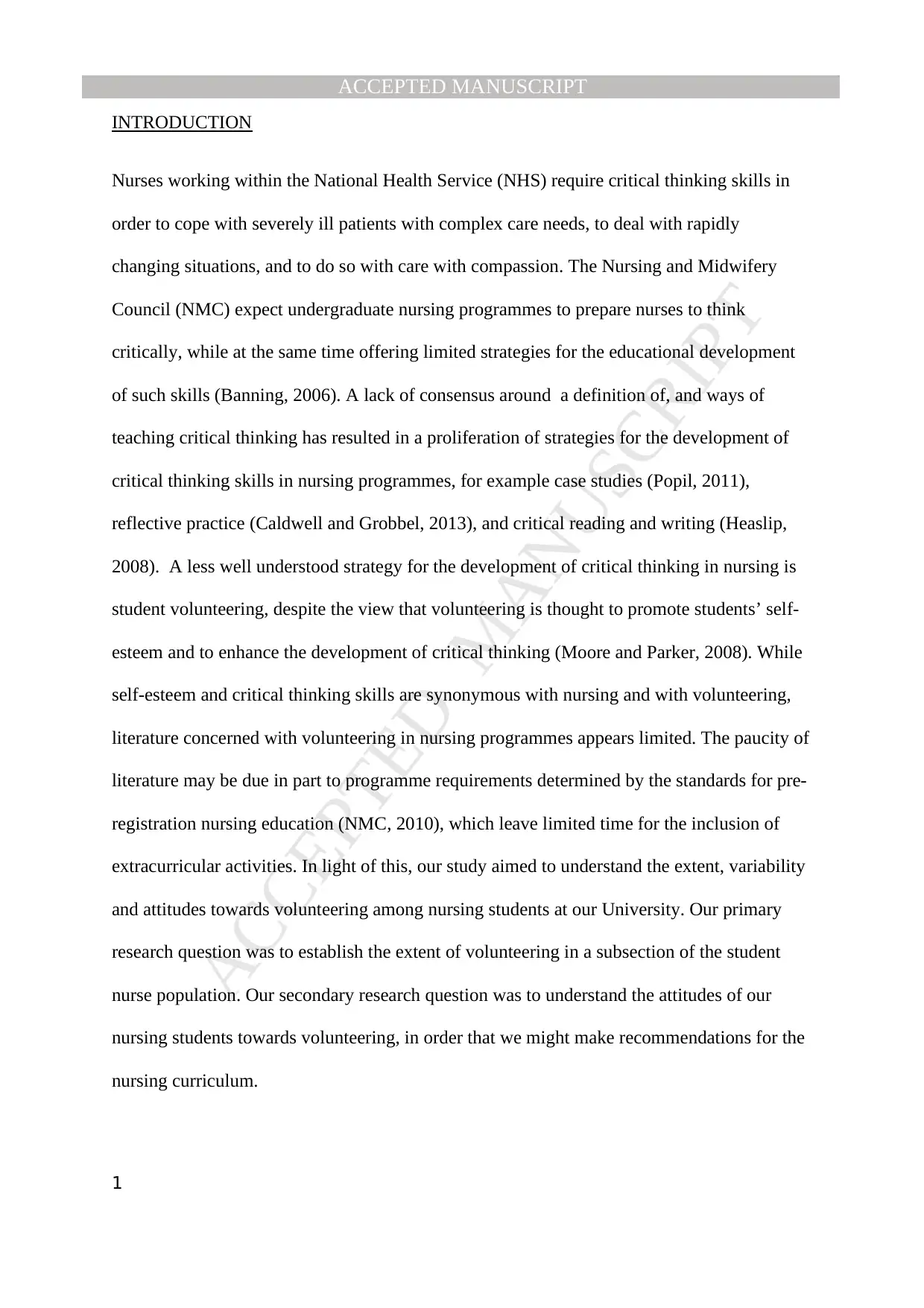
MANUSCRIPTACCEPTED
ACCEPTED MANUSCRIPT
1
INTRODUCTION
Nurses working within the National Health Service (NHS) require critical thinking skills in
order to cope with severely ill patients with complex care needs, to deal with rapidly
changing situations, and to do so with care with compassion. The Nursing and Midwifery
Council (NMC) expect undergraduate nursing programmes to prepare nurses to think
critically, while at the same time offering limited strategies for the educational development
of such skills (Banning, 2006). A lack of consensus around a definition of, and ways of
teaching critical thinking has resulted in a proliferation of strategies for the development of
critical thinking skills in nursing programmes, for example case studies (Popil, 2011),
reflective practice (Caldwell and Grobbel, 2013), and critical reading and writing (Heaslip,
2008). A less well understood strategy for the development of critical thinking in nursing is
student volunteering, despite the view that volunteering is thought to promote students’ self-
esteem and to enhance the development of critical thinking (Moore and Parker, 2008). While
self-esteem and critical thinking skills are synonymous with nursing and with volunteering,
literature concerned with volunteering in nursing programmes appears limited. The paucity of
literature may be due in part to programme requirements determined by the standards for pre-
registration nursing education (NMC, 2010), which leave limited time for the inclusion of
extracurricular activities. In light of this, our study aimed to understand the extent, variability
and attitudes towards volunteering among nursing students at our University. Our primary
research question was to establish the extent of volunteering in a subsection of the student
nurse population. Our secondary research question was to understand the attitudes of our
nursing students towards volunteering, in order that we might make recommendations for the
nursing curriculum.
ACCEPTED MANUSCRIPT
1
INTRODUCTION
Nurses working within the National Health Service (NHS) require critical thinking skills in
order to cope with severely ill patients with complex care needs, to deal with rapidly
changing situations, and to do so with care with compassion. The Nursing and Midwifery
Council (NMC) expect undergraduate nursing programmes to prepare nurses to think
critically, while at the same time offering limited strategies for the educational development
of such skills (Banning, 2006). A lack of consensus around a definition of, and ways of
teaching critical thinking has resulted in a proliferation of strategies for the development of
critical thinking skills in nursing programmes, for example case studies (Popil, 2011),
reflective practice (Caldwell and Grobbel, 2013), and critical reading and writing (Heaslip,
2008). A less well understood strategy for the development of critical thinking in nursing is
student volunteering, despite the view that volunteering is thought to promote students’ self-
esteem and to enhance the development of critical thinking (Moore and Parker, 2008). While
self-esteem and critical thinking skills are synonymous with nursing and with volunteering,
literature concerned with volunteering in nursing programmes appears limited. The paucity of
literature may be due in part to programme requirements determined by the standards for pre-
registration nursing education (NMC, 2010), which leave limited time for the inclusion of
extracurricular activities. In light of this, our study aimed to understand the extent, variability
and attitudes towards volunteering among nursing students at our University. Our primary
research question was to establish the extent of volunteering in a subsection of the student
nurse population. Our secondary research question was to understand the attitudes of our
nursing students towards volunteering, in order that we might make recommendations for the
nursing curriculum.
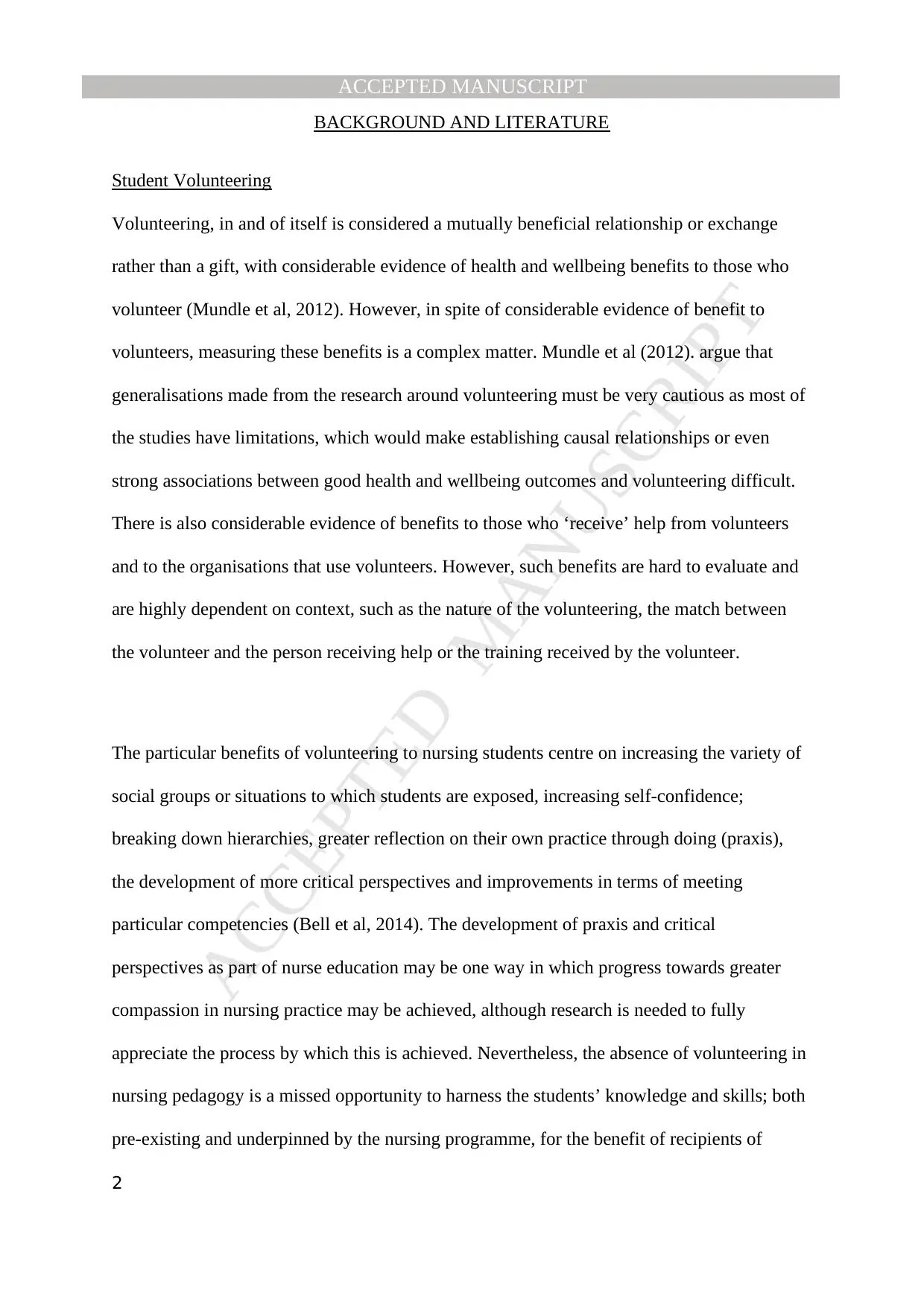
MANUSCRIPTACCEPTED
ACCEPTED MANUSCRIPT
2
BACKGROUND AND LITERATURE
Student Volunteering
Volunteering, in and of itself is considered a mutually beneficial relationship or exchange
rather than a gift, with considerable evidence of health and wellbeing benefits to those who
volunteer (Mundle et al, 2012). However, in spite of considerable evidence of benefit to
volunteers, measuring these benefits is a complex matter. Mundle et al (2012). argue that
generalisations made from the research around volunteering must be very cautious as most of
the studies have limitations, which would make establishing causal relationships or even
strong associations between good health and wellbeing outcomes and volunteering difficult.
There is also considerable evidence of benefits to those who ‘receive’ help from volunteers
and to the organisations that use volunteers. However, such benefits are hard to evaluate and
are highly dependent on context, such as the nature of the volunteering, the match between
the volunteer and the person receiving help or the training received by the volunteer.
The particular benefits of volunteering to nursing students centre on increasing the variety of
social groups or situations to which students are exposed, increasing self-confidence;
breaking down hierarchies, greater reflection on their own practice through doing (praxis),
the development of more critical perspectives and improvements in terms of meeting
particular competencies (Bell et al, 2014). The development of praxis and critical
perspectives as part of nurse education may be one way in which progress towards greater
compassion in nursing practice may be achieved, although research is needed to fully
appreciate the process by which this is achieved. Nevertheless, the absence of volunteering in
nursing pedagogy is a missed opportunity to harness the students’ knowledge and skills; both
pre-existing and underpinned by the nursing programme, for the benefit of recipients of
ACCEPTED MANUSCRIPT
2
BACKGROUND AND LITERATURE
Student Volunteering
Volunteering, in and of itself is considered a mutually beneficial relationship or exchange
rather than a gift, with considerable evidence of health and wellbeing benefits to those who
volunteer (Mundle et al, 2012). However, in spite of considerable evidence of benefit to
volunteers, measuring these benefits is a complex matter. Mundle et al (2012). argue that
generalisations made from the research around volunteering must be very cautious as most of
the studies have limitations, which would make establishing causal relationships or even
strong associations between good health and wellbeing outcomes and volunteering difficult.
There is also considerable evidence of benefits to those who ‘receive’ help from volunteers
and to the organisations that use volunteers. However, such benefits are hard to evaluate and
are highly dependent on context, such as the nature of the volunteering, the match between
the volunteer and the person receiving help or the training received by the volunteer.
The particular benefits of volunteering to nursing students centre on increasing the variety of
social groups or situations to which students are exposed, increasing self-confidence;
breaking down hierarchies, greater reflection on their own practice through doing (praxis),
the development of more critical perspectives and improvements in terms of meeting
particular competencies (Bell et al, 2014). The development of praxis and critical
perspectives as part of nurse education may be one way in which progress towards greater
compassion in nursing practice may be achieved, although research is needed to fully
appreciate the process by which this is achieved. Nevertheless, the absence of volunteering in
nursing pedagogy is a missed opportunity to harness the students’ knowledge and skills; both
pre-existing and underpinned by the nursing programme, for the benefit of recipients of
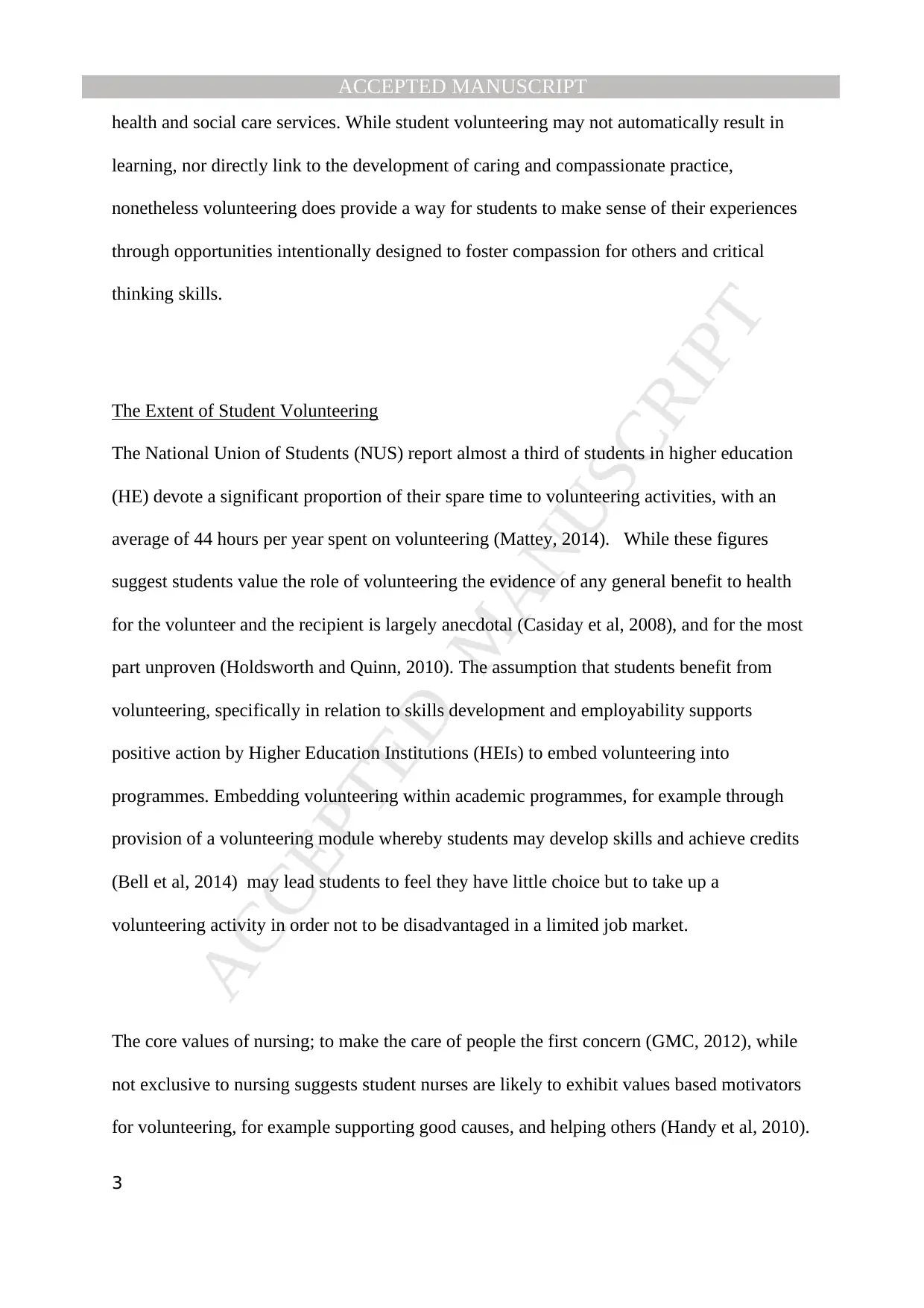
MANUSCRIPTACCEPTED
ACCEPTED MANUSCRIPT
3
health and social care services. While student volunteering may not automatically result in
learning, nor directly link to the development of caring and compassionate practice,
nonetheless volunteering does provide a way for students to make sense of their experiences
through opportunities intentionally designed to foster compassion for others and critical
thinking skills.
The Extent of Student Volunteering
The National Union of Students (NUS) report almost a third of students in higher education
(HE) devote a significant proportion of their spare time to volunteering activities, with an
average of 44 hours per year spent on volunteering (Mattey, 2014). While these figures
suggest students value the role of volunteering the evidence of any general benefit to health
for the volunteer and the recipient is largely anecdotal (Casiday et al, 2008), and for the most
part unproven (Holdsworth and Quinn, 2010). The assumption that students benefit from
volunteering, specifically in relation to skills development and employability supports
positive action by Higher Education Institutions (HEIs) to embed volunteering into
programmes. Embedding volunteering within academic programmes, for example through
provision of a volunteering module whereby students may develop skills and achieve credits
(Bell et al, 2014) may lead students to feel they have little choice but to take up a
volunteering activity in order not to be disadvantaged in a limited job market.
The core values of nursing; to make the care of people the first concern (GMC, 2012), while
not exclusive to nursing suggests student nurses are likely to exhibit values based motivators
for volunteering, for example supporting good causes, and helping others (Handy et al, 2010).
ACCEPTED MANUSCRIPT
3
health and social care services. While student volunteering may not automatically result in
learning, nor directly link to the development of caring and compassionate practice,
nonetheless volunteering does provide a way for students to make sense of their experiences
through opportunities intentionally designed to foster compassion for others and critical
thinking skills.
The Extent of Student Volunteering
The National Union of Students (NUS) report almost a third of students in higher education
(HE) devote a significant proportion of their spare time to volunteering activities, with an
average of 44 hours per year spent on volunteering (Mattey, 2014). While these figures
suggest students value the role of volunteering the evidence of any general benefit to health
for the volunteer and the recipient is largely anecdotal (Casiday et al, 2008), and for the most
part unproven (Holdsworth and Quinn, 2010). The assumption that students benefit from
volunteering, specifically in relation to skills development and employability supports
positive action by Higher Education Institutions (HEIs) to embed volunteering into
programmes. Embedding volunteering within academic programmes, for example through
provision of a volunteering module whereby students may develop skills and achieve credits
(Bell et al, 2014) may lead students to feel they have little choice but to take up a
volunteering activity in order not to be disadvantaged in a limited job market.
The core values of nursing; to make the care of people the first concern (GMC, 2012), while
not exclusive to nursing suggests student nurses are likely to exhibit values based motivators
for volunteering, for example supporting good causes, and helping others (Handy et al, 2010).
Paraphrase This Document
Need a fresh take? Get an instant paraphrase of this document with our AI Paraphraser
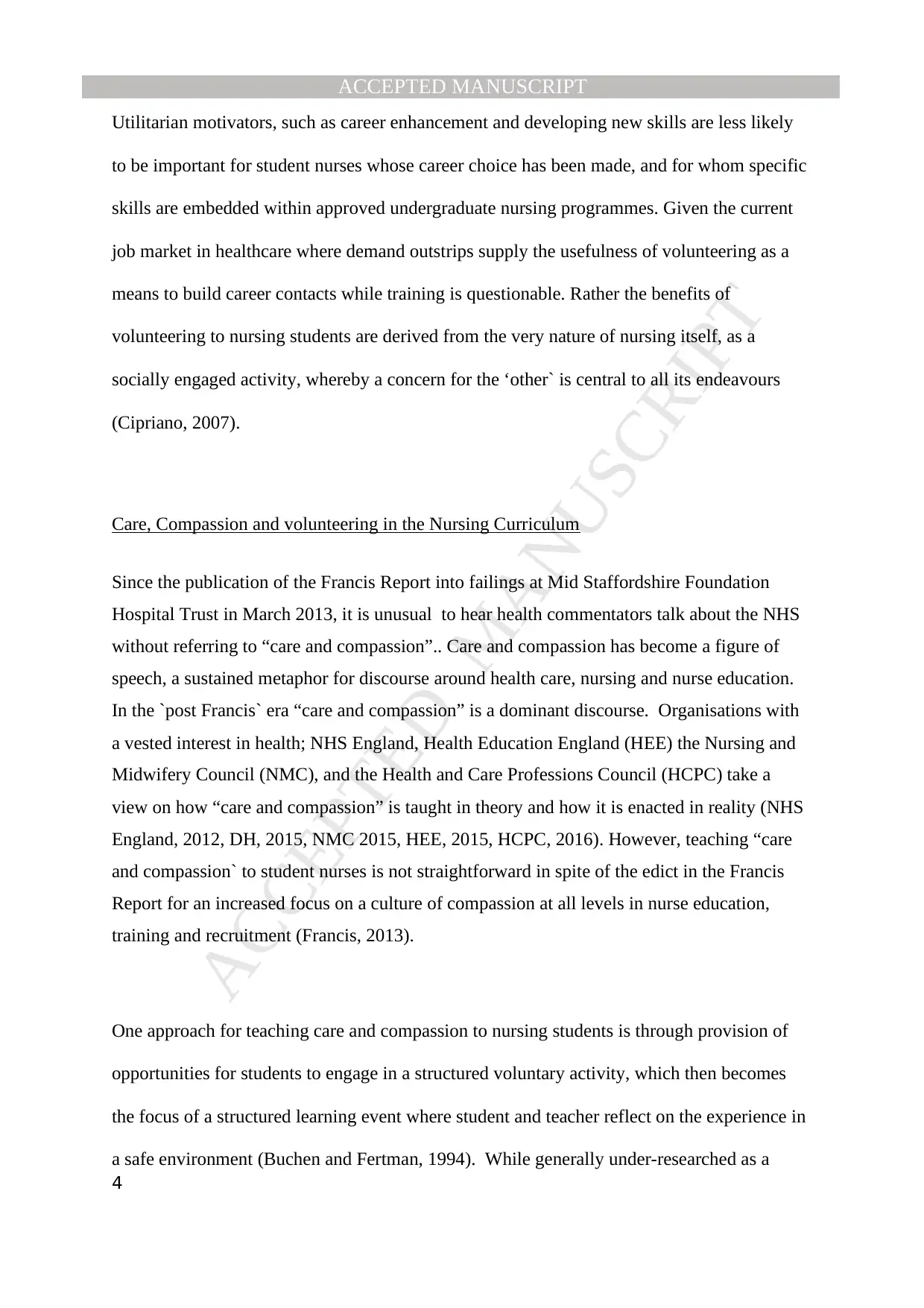
MANUSCRIPTACCEPTED
ACCEPTED MANUSCRIPT
4
Utilitarian motivators, such as career enhancement and developing new skills are less likely
to be important for student nurses whose career choice has been made, and for whom specific
skills are embedded within approved undergraduate nursing programmes. Given the current
job market in healthcare where demand outstrips supply the usefulness of volunteering as a
means to build career contacts while training is questionable. Rather the benefits of
volunteering to nursing students are derived from the very nature of nursing itself, as a
socially engaged activity, whereby a concern for the ‘other` is central to all its endeavours
(Cipriano, 2007).
Care, Compassion and volunteering in the Nursing Curriculum
Since the publication of the Francis Report into failings at Mid Staffordshire Foundation
Hospital Trust in March 2013, it is unusual to hear health commentators talk about the NHS
without referring to “care and compassion”.. Care and compassion has become a figure of
speech, a sustained metaphor for discourse around health care, nursing and nurse education.
In the `post Francis` era “care and compassion” is a dominant discourse. Organisations with
a vested interest in health; NHS England, Health Education England (HEE) the Nursing and
Midwifery Council (NMC), and the Health and Care Professions Council (HCPC) take a
view on how “care and compassion” is taught in theory and how it is enacted in reality (NHS
England, 2012, DH, 2015, NMC 2015, HEE, 2015, HCPC, 2016). However, teaching “care
and compassion` to student nurses is not straightforward in spite of the edict in the Francis
Report for an increased focus on a culture of compassion at all levels in nurse education,
training and recruitment (Francis, 2013).
One approach for teaching care and compassion to nursing students is through provision of
opportunities for students to engage in a structured voluntary activity, which then becomes
the focus of a structured learning event where student and teacher reflect on the experience in
a safe environment (Buchen and Fertman, 1994). While generally under-researched as a
ACCEPTED MANUSCRIPT
4
Utilitarian motivators, such as career enhancement and developing new skills are less likely
to be important for student nurses whose career choice has been made, and for whom specific
skills are embedded within approved undergraduate nursing programmes. Given the current
job market in healthcare where demand outstrips supply the usefulness of volunteering as a
means to build career contacts while training is questionable. Rather the benefits of
volunteering to nursing students are derived from the very nature of nursing itself, as a
socially engaged activity, whereby a concern for the ‘other` is central to all its endeavours
(Cipriano, 2007).
Care, Compassion and volunteering in the Nursing Curriculum
Since the publication of the Francis Report into failings at Mid Staffordshire Foundation
Hospital Trust in March 2013, it is unusual to hear health commentators talk about the NHS
without referring to “care and compassion”.. Care and compassion has become a figure of
speech, a sustained metaphor for discourse around health care, nursing and nurse education.
In the `post Francis` era “care and compassion” is a dominant discourse. Organisations with
a vested interest in health; NHS England, Health Education England (HEE) the Nursing and
Midwifery Council (NMC), and the Health and Care Professions Council (HCPC) take a
view on how “care and compassion” is taught in theory and how it is enacted in reality (NHS
England, 2012, DH, 2015, NMC 2015, HEE, 2015, HCPC, 2016). However, teaching “care
and compassion` to student nurses is not straightforward in spite of the edict in the Francis
Report for an increased focus on a culture of compassion at all levels in nurse education,
training and recruitment (Francis, 2013).
One approach for teaching care and compassion to nursing students is through provision of
opportunities for students to engage in a structured voluntary activity, which then becomes
the focus of a structured learning event where student and teacher reflect on the experience in
a safe environment (Buchen and Fertman, 1994). While generally under-researched as a
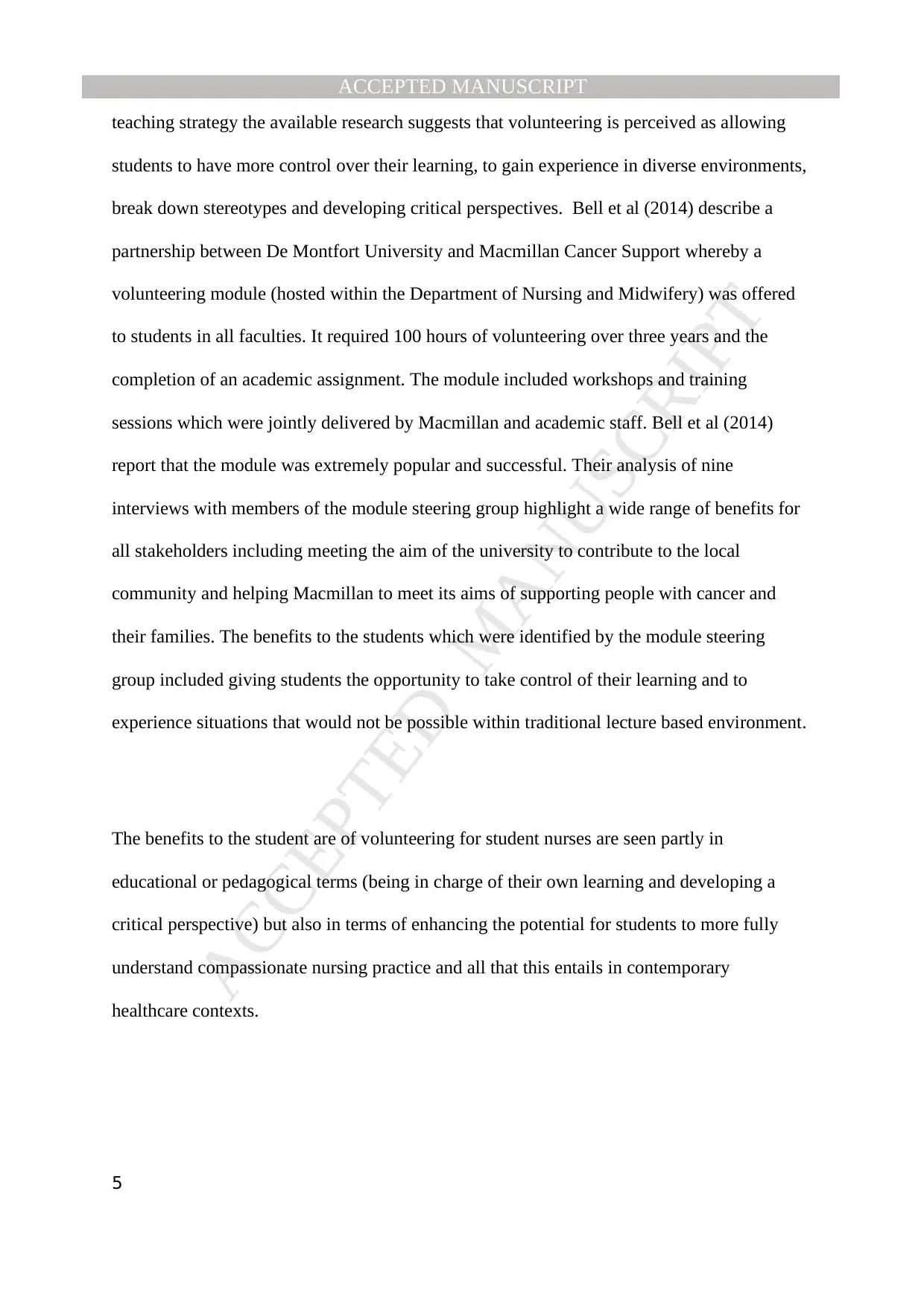
MANUSCRIPTACCEPTED
ACCEPTED MANUSCRIPT
5
teaching strategy the available research suggests that volunteering is perceived as allowing
students to have more control over their learning, to gain experience in diverse environments,
break down stereotypes and developing critical perspectives. Bell et al (2014) describe a
partnership between De Montfort University and Macmillan Cancer Support whereby a
volunteering module (hosted within the Department of Nursing and Midwifery) was offered
to students in all faculties. It required 100 hours of volunteering over three years and the
completion of an academic assignment. The module included workshops and training
sessions which were jointly delivered by Macmillan and academic staff. Bell et al (2014)
report that the module was extremely popular and successful. Their analysis of nine
interviews with members of the module steering group highlight a wide range of benefits for
all stakeholders including meeting the aim of the university to contribute to the local
community and helping Macmillan to meet its aims of supporting people with cancer and
their families. The benefits to the students which were identified by the module steering
group included giving students the opportunity to take control of their learning and to
experience situations that would not be possible within traditional lecture based environment.
The benefits to the student are of volunteering for student nurses are seen partly in
educational or pedagogical terms (being in charge of their own learning and developing a
critical perspective) but also in terms of enhancing the potential for students to more fully
understand compassionate nursing practice and all that this entails in contemporary
healthcare contexts.
ACCEPTED MANUSCRIPT
5
teaching strategy the available research suggests that volunteering is perceived as allowing
students to have more control over their learning, to gain experience in diverse environments,
break down stereotypes and developing critical perspectives. Bell et al (2014) describe a
partnership between De Montfort University and Macmillan Cancer Support whereby a
volunteering module (hosted within the Department of Nursing and Midwifery) was offered
to students in all faculties. It required 100 hours of volunteering over three years and the
completion of an academic assignment. The module included workshops and training
sessions which were jointly delivered by Macmillan and academic staff. Bell et al (2014)
report that the module was extremely popular and successful. Their analysis of nine
interviews with members of the module steering group highlight a wide range of benefits for
all stakeholders including meeting the aim of the university to contribute to the local
community and helping Macmillan to meet its aims of supporting people with cancer and
their families. The benefits to the students which were identified by the module steering
group included giving students the opportunity to take control of their learning and to
experience situations that would not be possible within traditional lecture based environment.
The benefits to the student are of volunteering for student nurses are seen partly in
educational or pedagogical terms (being in charge of their own learning and developing a
critical perspective) but also in terms of enhancing the potential for students to more fully
understand compassionate nursing practice and all that this entails in contemporary
healthcare contexts.
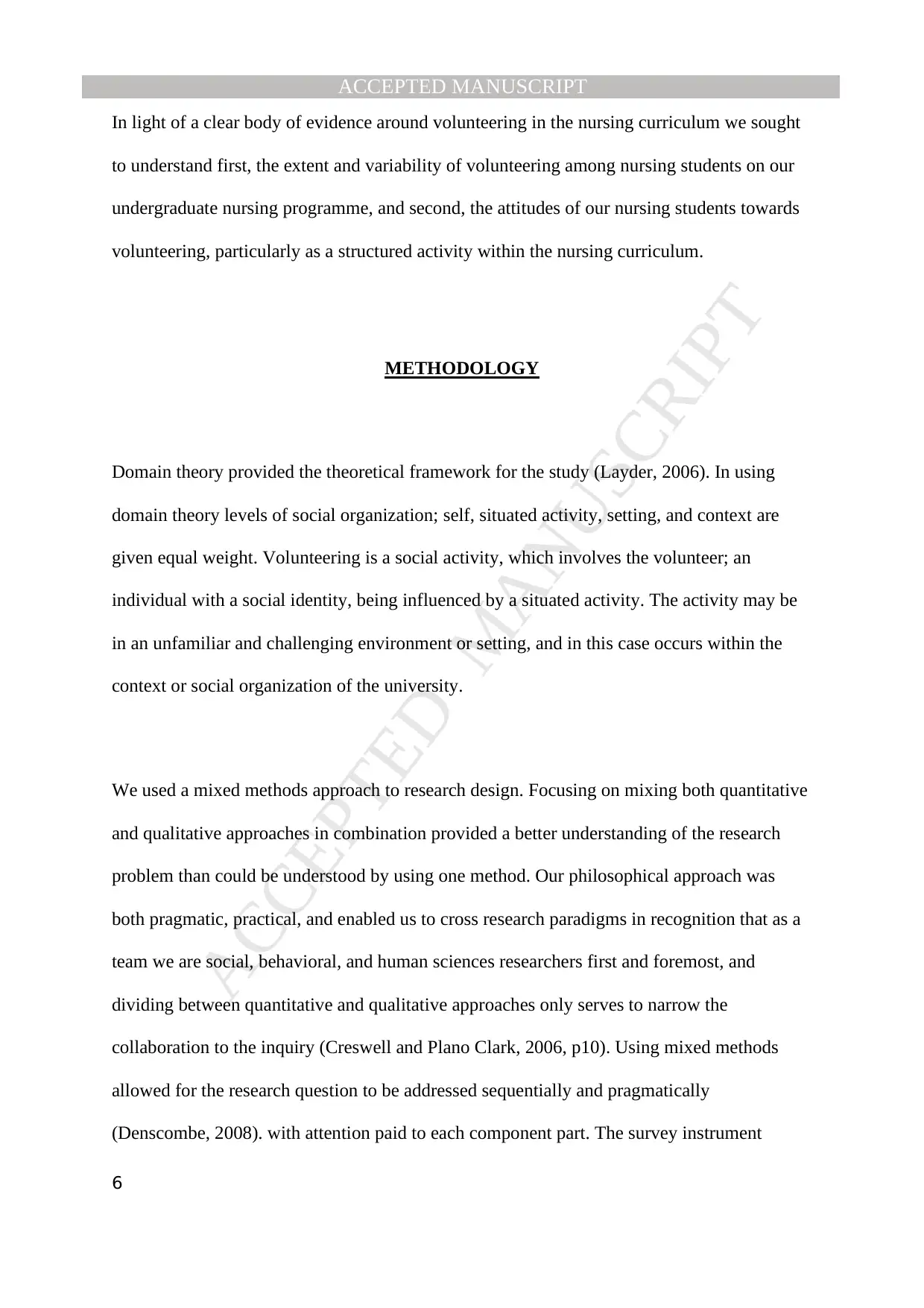
MANUSCRIPTACCEPTED
ACCEPTED MANUSCRIPT
6
In light of a clear body of evidence around volunteering in the nursing curriculum we sought
to understand first, the extent and variability of volunteering among nursing students on our
undergraduate nursing programme, and second, the attitudes of our nursing students towards
volunteering, particularly as a structured activity within the nursing curriculum.
METHODOLOGY
Domain theory provided the theoretical framework for the study (Layder, 2006). In using
domain theory levels of social organization; self, situated activity, setting, and context are
given equal weight. Volunteering is a social activity, which involves the volunteer; an
individual with a social identity, being influenced by a situated activity. The activity may be
in an unfamiliar and challenging environment or setting, and in this case occurs within the
context or social organization of the university.
We used a mixed methods approach to research design. Focusing on mixing both quantitative
and qualitative approaches in combination provided a better understanding of the research
problem than could be understood by using one method. Our philosophical approach was
both pragmatic, practical, and enabled us to cross research paradigms in recognition that as a
team we are social, behavioral, and human sciences researchers first and foremost, and
dividing between quantitative and qualitative approaches only serves to narrow the
collaboration to the inquiry (Creswell and Plano Clark, 2006, p10). Using mixed methods
allowed for the research question to be addressed sequentially and pragmatically
(Denscombe, 2008). with attention paid to each component part. The survey instrument
ACCEPTED MANUSCRIPT
6
In light of a clear body of evidence around volunteering in the nursing curriculum we sought
to understand first, the extent and variability of volunteering among nursing students on our
undergraduate nursing programme, and second, the attitudes of our nursing students towards
volunteering, particularly as a structured activity within the nursing curriculum.
METHODOLOGY
Domain theory provided the theoretical framework for the study (Layder, 2006). In using
domain theory levels of social organization; self, situated activity, setting, and context are
given equal weight. Volunteering is a social activity, which involves the volunteer; an
individual with a social identity, being influenced by a situated activity. The activity may be
in an unfamiliar and challenging environment or setting, and in this case occurs within the
context or social organization of the university.
We used a mixed methods approach to research design. Focusing on mixing both quantitative
and qualitative approaches in combination provided a better understanding of the research
problem than could be understood by using one method. Our philosophical approach was
both pragmatic, practical, and enabled us to cross research paradigms in recognition that as a
team we are social, behavioral, and human sciences researchers first and foremost, and
dividing between quantitative and qualitative approaches only serves to narrow the
collaboration to the inquiry (Creswell and Plano Clark, 2006, p10). Using mixed methods
allowed for the research question to be addressed sequentially and pragmatically
(Denscombe, 2008). with attention paid to each component part. The survey instrument
Secure Best Marks with AI Grader
Need help grading? Try our AI Grader for instant feedback on your assignments.
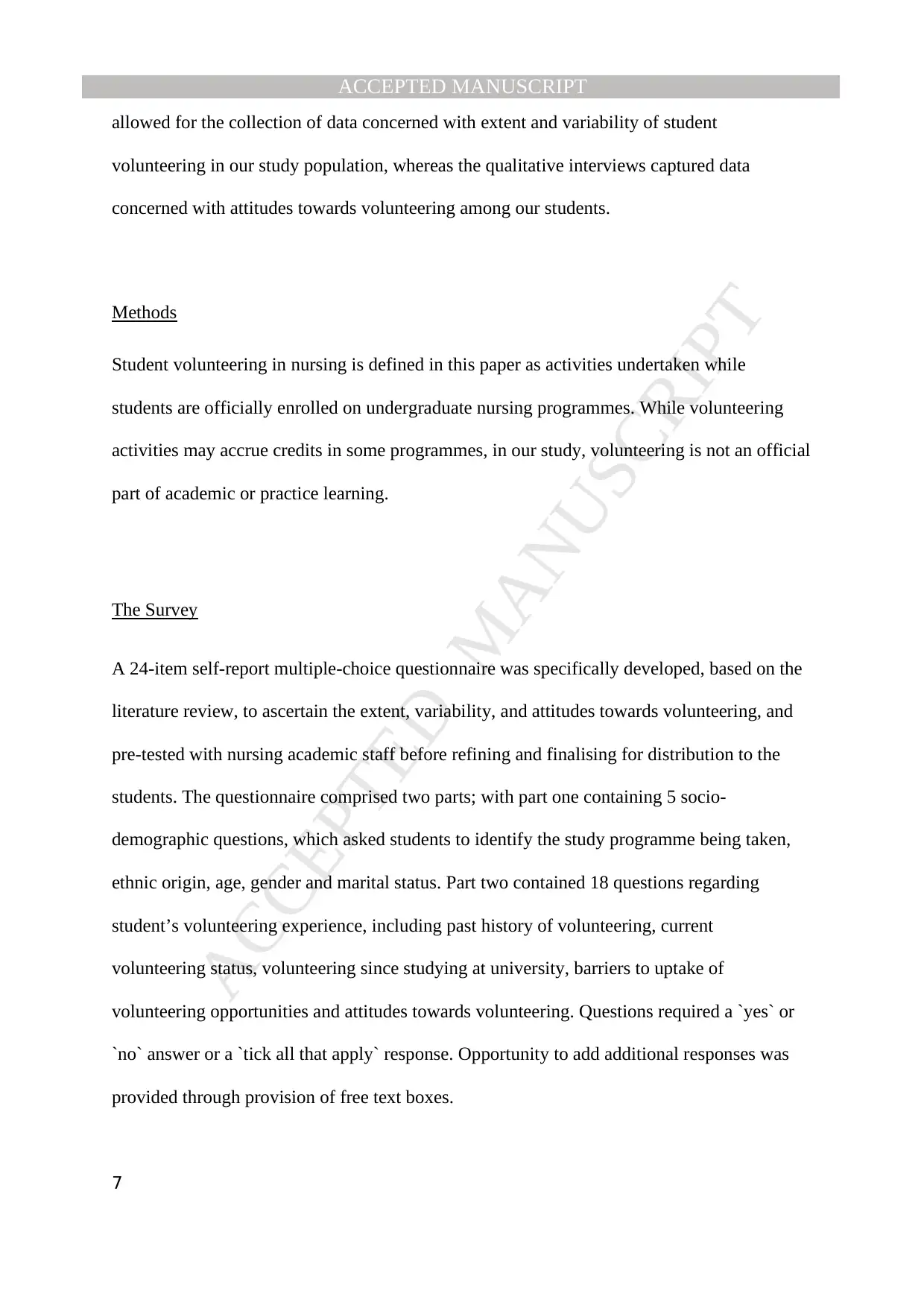
MANUSCRIPTACCEPTED
ACCEPTED MANUSCRIPT
7
allowed for the collection of data concerned with extent and variability of student
volunteering in our study population, whereas the qualitative interviews captured data
concerned with attitudes towards volunteering among our students.
Methods
Student volunteering in nursing is defined in this paper as activities undertaken while
students are officially enrolled on undergraduate nursing programmes. While volunteering
activities may accrue credits in some programmes, in our study, volunteering is not an official
part of academic or practice learning.
The Survey
A 24-item self-report multiple-choice questionnaire was specifically developed, based on the
literature review, to ascertain the extent, variability, and attitudes towards volunteering, and
pre-tested with nursing academic staff before refining and finalising for distribution to the
students. The questionnaire comprised two parts; with part one containing 5 socio-
demographic questions, which asked students to identify the study programme being taken,
ethnic origin, age, gender and marital status. Part two contained 18 questions regarding
student’s volunteering experience, including past history of volunteering, current
volunteering status, volunteering since studying at university, barriers to uptake of
volunteering opportunities and attitudes towards volunteering. Questions required a `yes` or
`no` answer or a `tick all that apply` response. Opportunity to add additional responses was
provided through provision of free text boxes.
ACCEPTED MANUSCRIPT
7
allowed for the collection of data concerned with extent and variability of student
volunteering in our study population, whereas the qualitative interviews captured data
concerned with attitudes towards volunteering among our students.
Methods
Student volunteering in nursing is defined in this paper as activities undertaken while
students are officially enrolled on undergraduate nursing programmes. While volunteering
activities may accrue credits in some programmes, in our study, volunteering is not an official
part of academic or practice learning.
The Survey
A 24-item self-report multiple-choice questionnaire was specifically developed, based on the
literature review, to ascertain the extent, variability, and attitudes towards volunteering, and
pre-tested with nursing academic staff before refining and finalising for distribution to the
students. The questionnaire comprised two parts; with part one containing 5 socio-
demographic questions, which asked students to identify the study programme being taken,
ethnic origin, age, gender and marital status. Part two contained 18 questions regarding
student’s volunteering experience, including past history of volunteering, current
volunteering status, volunteering since studying at university, barriers to uptake of
volunteering opportunities and attitudes towards volunteering. Questions required a `yes` or
`no` answer or a `tick all that apply` response. Opportunity to add additional responses was
provided through provision of free text boxes.
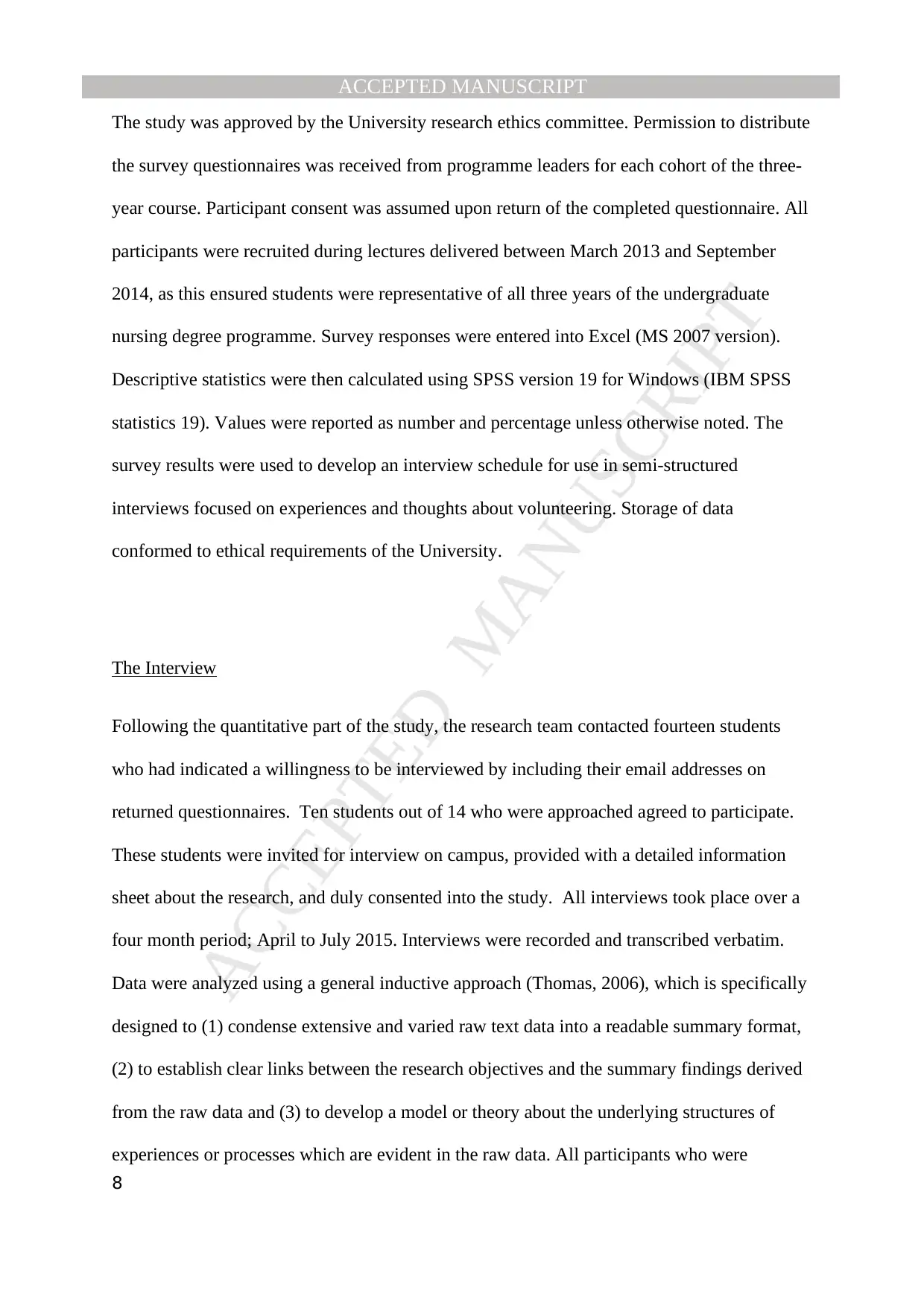
MANUSCRIPTACCEPTED
ACCEPTED MANUSCRIPT
8
The study was approved by the University research ethics committee. Permission to distribute
the survey questionnaires was received from programme leaders for each cohort of the three-
year course. Participant consent was assumed upon return of the completed questionnaire. All
participants were recruited during lectures delivered between March 2013 and September
2014, as this ensured students were representative of all three years of the undergraduate
nursing degree programme. Survey responses were entered into Excel (MS 2007 version).
Descriptive statistics were then calculated using SPSS version 19 for Windows (IBM SPSS
statistics 19). Values were reported as number and percentage unless otherwise noted. The
survey results were used to develop an interview schedule for use in semi-structured
interviews focused on experiences and thoughts about volunteering. Storage of data
conformed to ethical requirements of the University.
The Interview
Following the quantitative part of the study, the research team contacted fourteen students
who had indicated a willingness to be interviewed by including their email addresses on
returned questionnaires. Ten students out of 14 who were approached agreed to participate.
These students were invited for interview on campus, provided with a detailed information
sheet about the research, and duly consented into the study. All interviews took place over a
four month period; April to July 2015. Interviews were recorded and transcribed verbatim.
Data were analyzed using a general inductive approach (Thomas, 2006), which is specifically
designed to (1) condense extensive and varied raw text data into a readable summary format,
(2) to establish clear links between the research objectives and the summary findings derived
from the raw data and (3) to develop a model or theory about the underlying structures of
experiences or processes which are evident in the raw data. All participants who were
ACCEPTED MANUSCRIPT
8
The study was approved by the University research ethics committee. Permission to distribute
the survey questionnaires was received from programme leaders for each cohort of the three-
year course. Participant consent was assumed upon return of the completed questionnaire. All
participants were recruited during lectures delivered between March 2013 and September
2014, as this ensured students were representative of all three years of the undergraduate
nursing degree programme. Survey responses were entered into Excel (MS 2007 version).
Descriptive statistics were then calculated using SPSS version 19 for Windows (IBM SPSS
statistics 19). Values were reported as number and percentage unless otherwise noted. The
survey results were used to develop an interview schedule for use in semi-structured
interviews focused on experiences and thoughts about volunteering. Storage of data
conformed to ethical requirements of the University.
The Interview
Following the quantitative part of the study, the research team contacted fourteen students
who had indicated a willingness to be interviewed by including their email addresses on
returned questionnaires. Ten students out of 14 who were approached agreed to participate.
These students were invited for interview on campus, provided with a detailed information
sheet about the research, and duly consented into the study. All interviews took place over a
four month period; April to July 2015. Interviews were recorded and transcribed verbatim.
Data were analyzed using a general inductive approach (Thomas, 2006), which is specifically
designed to (1) condense extensive and varied raw text data into a readable summary format,
(2) to establish clear links between the research objectives and the summary findings derived
from the raw data and (3) to develop a model or theory about the underlying structures of
experiences or processes which are evident in the raw data. All participants who were
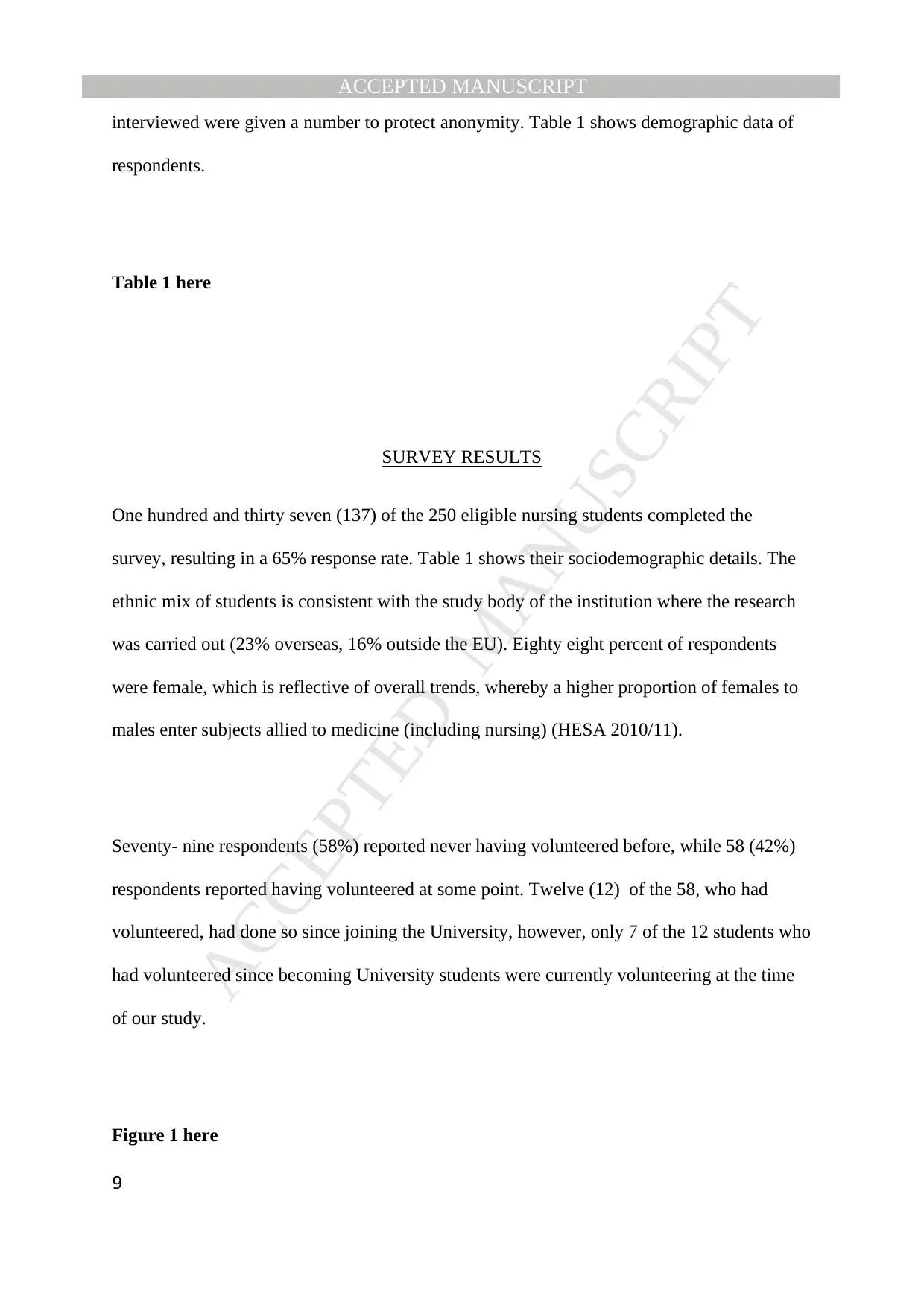
MANUSCRIPTACCEPTED
ACCEPTED MANUSCRIPT
9
interviewed were given a number to protect anonymity. Table 1 shows demographic data of
respondents.
Table 1 here
SURVEY RESULTS
One hundred and thirty seven (137) of the 250 eligible nursing students completed the
survey, resulting in a 65% response rate. Table 1 shows their sociodemographic details. The
ethnic mix of students is consistent with the study body of the institution where the research
was carried out (23% overseas, 16% outside the EU). Eighty eight percent of respondents
were female, which is reflective of overall trends, whereby a higher proportion of females to
males enter subjects allied to medicine (including nursing) (HESA 2010/11).
Seventy- nine respondents (58%) reported never having volunteered before, while 58 (42%)
respondents reported having volunteered at some point. Twelve (12) of the 58, who had
volunteered, had done so since joining the University, however, only 7 of the 12 students who
had volunteered since becoming University students were currently volunteering at the time
of our study.
Figure 1 here
ACCEPTED MANUSCRIPT
9
interviewed were given a number to protect anonymity. Table 1 shows demographic data of
respondents.
Table 1 here
SURVEY RESULTS
One hundred and thirty seven (137) of the 250 eligible nursing students completed the
survey, resulting in a 65% response rate. Table 1 shows their sociodemographic details. The
ethnic mix of students is consistent with the study body of the institution where the research
was carried out (23% overseas, 16% outside the EU). Eighty eight percent of respondents
were female, which is reflective of overall trends, whereby a higher proportion of females to
males enter subjects allied to medicine (including nursing) (HESA 2010/11).
Seventy- nine respondents (58%) reported never having volunteered before, while 58 (42%)
respondents reported having volunteered at some point. Twelve (12) of the 58, who had
volunteered, had done so since joining the University, however, only 7 of the 12 students who
had volunteered since becoming University students were currently volunteering at the time
of our study.
Figure 1 here
Paraphrase This Document
Need a fresh take? Get an instant paraphrase of this document with our AI Paraphraser
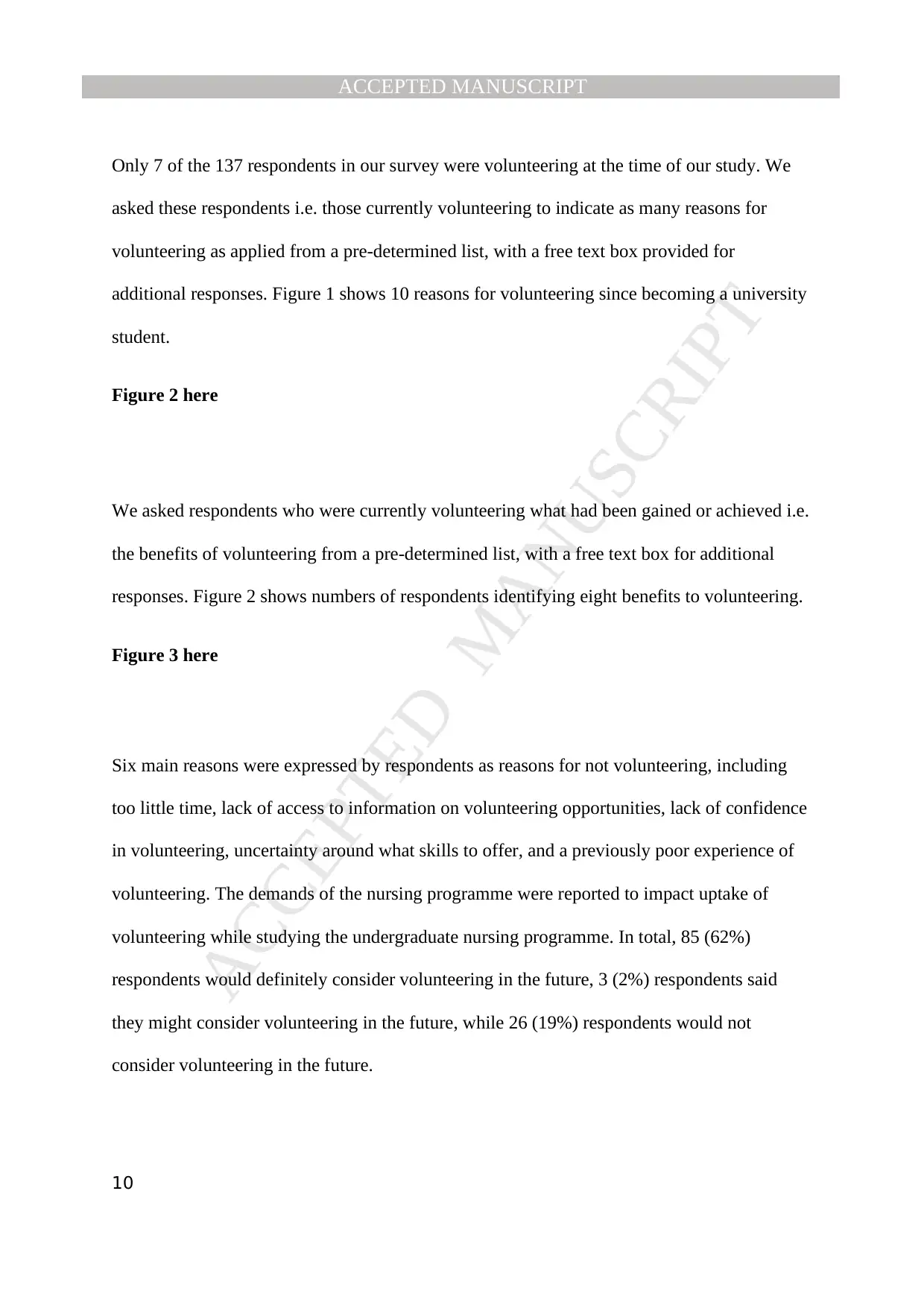
MANUSCRIPTACCEPTED
ACCEPTED MANUSCRIPT
10
Only 7 of the 137 respondents in our survey were volunteering at the time of our study. We
asked these respondents i.e. those currently volunteering to indicate as many reasons for
volunteering as applied from a pre-determined list, with a free text box provided for
additional responses. Figure 1 shows 10 reasons for volunteering since becoming a university
student.
Figure 2 here
We asked respondents who were currently volunteering what had been gained or achieved i.e.
the benefits of volunteering from a pre-determined list, with a free text box for additional
responses. Figure 2 shows numbers of respondents identifying eight benefits to volunteering.
Figure 3 here
Six main reasons were expressed by respondents as reasons for not volunteering, including
too little time, lack of access to information on volunteering opportunities, lack of confidence
in volunteering, uncertainty around what skills to offer, and a previously poor experience of
volunteering. The demands of the nursing programme were reported to impact uptake of
volunteering while studying the undergraduate nursing programme. In total, 85 (62%)
respondents would definitely consider volunteering in the future, 3 (2%) respondents said
they might consider volunteering in the future, while 26 (19%) respondents would not
consider volunteering in the future.
ACCEPTED MANUSCRIPT
10
Only 7 of the 137 respondents in our survey were volunteering at the time of our study. We
asked these respondents i.e. those currently volunteering to indicate as many reasons for
volunteering as applied from a pre-determined list, with a free text box provided for
additional responses. Figure 1 shows 10 reasons for volunteering since becoming a university
student.
Figure 2 here
We asked respondents who were currently volunteering what had been gained or achieved i.e.
the benefits of volunteering from a pre-determined list, with a free text box for additional
responses. Figure 2 shows numbers of respondents identifying eight benefits to volunteering.
Figure 3 here
Six main reasons were expressed by respondents as reasons for not volunteering, including
too little time, lack of access to information on volunteering opportunities, lack of confidence
in volunteering, uncertainty around what skills to offer, and a previously poor experience of
volunteering. The demands of the nursing programme were reported to impact uptake of
volunteering while studying the undergraduate nursing programme. In total, 85 (62%)
respondents would definitely consider volunteering in the future, 3 (2%) respondents said
they might consider volunteering in the future, while 26 (19%) respondents would not
consider volunteering in the future.
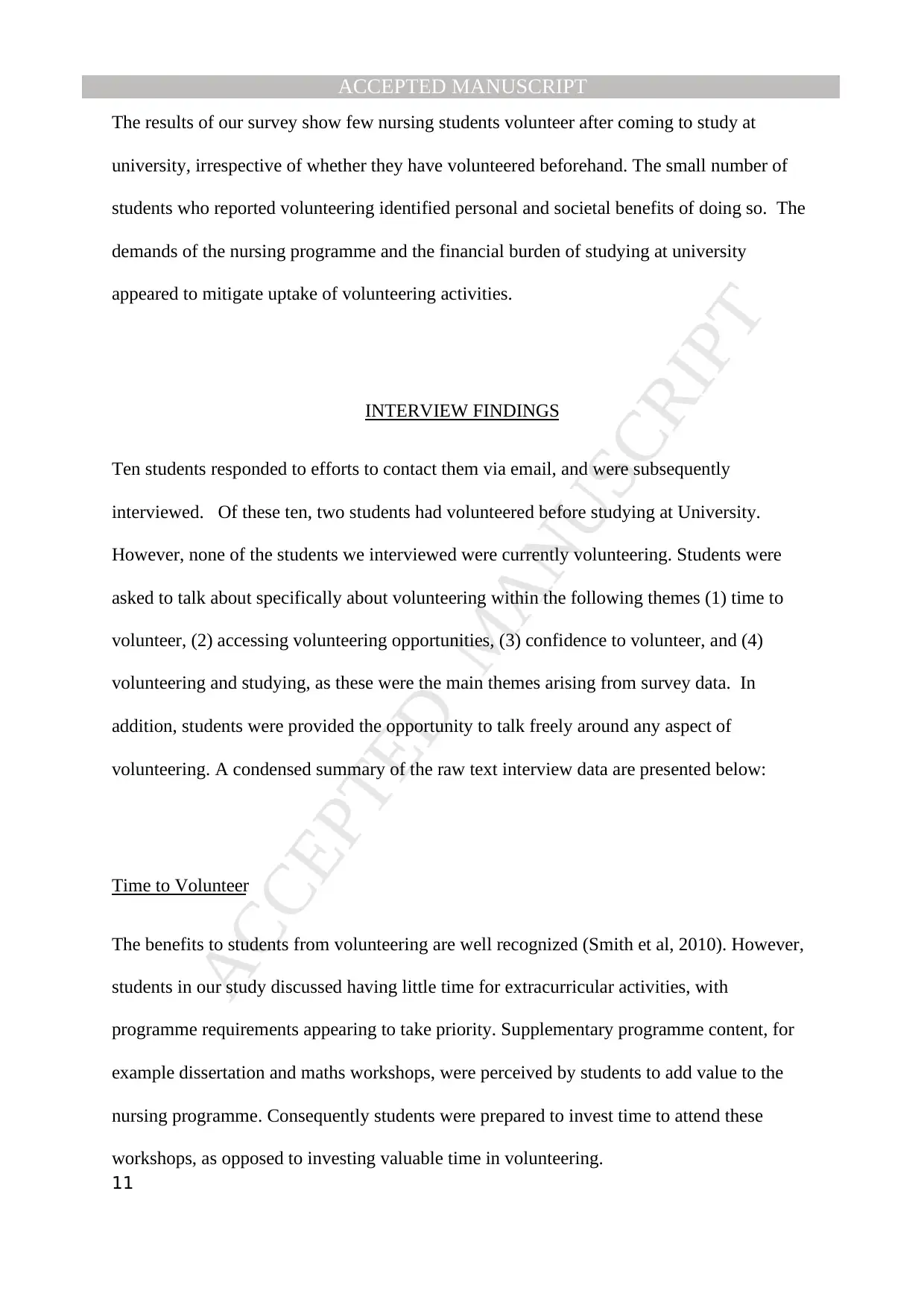
MANUSCRIPTACCEPTED
ACCEPTED MANUSCRIPT
11
The results of our survey show few nursing students volunteer after coming to study at
university, irrespective of whether they have volunteered beforehand. The small number of
students who reported volunteering identified personal and societal benefits of doing so. The
demands of the nursing programme and the financial burden of studying at university
appeared to mitigate uptake of volunteering activities.
INTERVIEW FINDINGS
Ten students responded to efforts to contact them via email, and were subsequently
interviewed. Of these ten, two students had volunteered before studying at University.
However, none of the students we interviewed were currently volunteering. Students were
asked to talk about specifically about volunteering within the following themes (1) time to
volunteer, (2) accessing volunteering opportunities, (3) confidence to volunteer, and (4)
volunteering and studying, as these were the main themes arising from survey data. In
addition, students were provided the opportunity to talk freely around any aspect of
volunteering. A condensed summary of the raw text interview data are presented below:
Time to Volunteer
The benefits to students from volunteering are well recognized (Smith et al, 2010). However,
students in our study discussed having little time for extracurricular activities, with
programme requirements appearing to take priority. Supplementary programme content, for
example dissertation and maths workshops, were perceived by students to add value to the
nursing programme. Consequently students were prepared to invest time to attend these
workshops, as opposed to investing valuable time in volunteering.
ACCEPTED MANUSCRIPT
11
The results of our survey show few nursing students volunteer after coming to study at
university, irrespective of whether they have volunteered beforehand. The small number of
students who reported volunteering identified personal and societal benefits of doing so. The
demands of the nursing programme and the financial burden of studying at university
appeared to mitigate uptake of volunteering activities.
INTERVIEW FINDINGS
Ten students responded to efforts to contact them via email, and were subsequently
interviewed. Of these ten, two students had volunteered before studying at University.
However, none of the students we interviewed were currently volunteering. Students were
asked to talk about specifically about volunteering within the following themes (1) time to
volunteer, (2) accessing volunteering opportunities, (3) confidence to volunteer, and (4)
volunteering and studying, as these were the main themes arising from survey data. In
addition, students were provided the opportunity to talk freely around any aspect of
volunteering. A condensed summary of the raw text interview data are presented below:
Time to Volunteer
The benefits to students from volunteering are well recognized (Smith et al, 2010). However,
students in our study discussed having little time for extracurricular activities, with
programme requirements appearing to take priority. Supplementary programme content, for
example dissertation and maths workshops, were perceived by students to add value to the
nursing programme. Consequently students were prepared to invest time to attend these
workshops, as opposed to investing valuable time in volunteering.
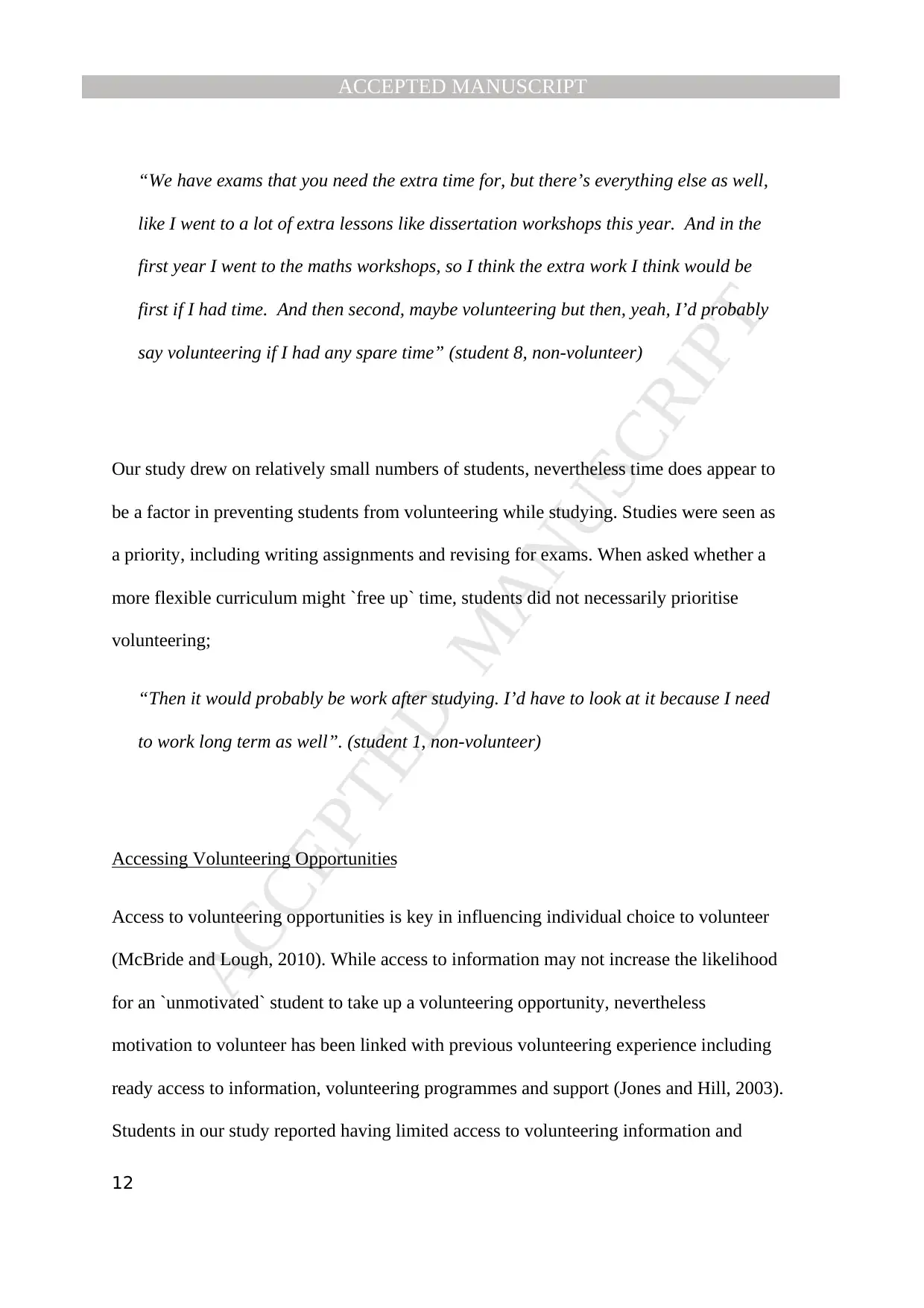
MANUSCRIPTACCEPTED
ACCEPTED MANUSCRIPT
12
“We have exams that you need the extra time for, but there’s everything else as well,
like I went to a lot of extra lessons like dissertation workshops this year. And in the
first year I went to the maths workshops, so I think the extra work I think would be
first if I had time. And then second, maybe volunteering but then, yeah, I’d probably
say volunteering if I had any spare time” (student 8, non-volunteer)
Our study drew on relatively small numbers of students, nevertheless time does appear to
be a factor in preventing students from volunteering while studying. Studies were seen as
a priority, including writing assignments and revising for exams. When asked whether a
more flexible curriculum might `free up` time, students did not necessarily prioritise
volunteering;
“Then it would probably be work after studying. I’d have to look at it because I need
to work long term as well”. (student 1, non-volunteer)
Accessing Volunteering Opportunities
Access to volunteering opportunities is key in influencing individual choice to volunteer
(McBride and Lough, 2010). While access to information may not increase the likelihood
for an `unmotivated` student to take up a volunteering opportunity, nevertheless
motivation to volunteer has been linked with previous volunteering experience including
ready access to information, volunteering programmes and support (Jones and Hill, 2003).
Students in our study reported having limited access to volunteering information and
ACCEPTED MANUSCRIPT
12
“We have exams that you need the extra time for, but there’s everything else as well,
like I went to a lot of extra lessons like dissertation workshops this year. And in the
first year I went to the maths workshops, so I think the extra work I think would be
first if I had time. And then second, maybe volunteering but then, yeah, I’d probably
say volunteering if I had any spare time” (student 8, non-volunteer)
Our study drew on relatively small numbers of students, nevertheless time does appear to
be a factor in preventing students from volunteering while studying. Studies were seen as
a priority, including writing assignments and revising for exams. When asked whether a
more flexible curriculum might `free up` time, students did not necessarily prioritise
volunteering;
“Then it would probably be work after studying. I’d have to look at it because I need
to work long term as well”. (student 1, non-volunteer)
Accessing Volunteering Opportunities
Access to volunteering opportunities is key in influencing individual choice to volunteer
(McBride and Lough, 2010). While access to information may not increase the likelihood
for an `unmotivated` student to take up a volunteering opportunity, nevertheless
motivation to volunteer has been linked with previous volunteering experience including
ready access to information, volunteering programmes and support (Jones and Hill, 2003).
Students in our study reported having limited access to volunteering information and
Secure Best Marks with AI Grader
Need help grading? Try our AI Grader for instant feedback on your assignments.
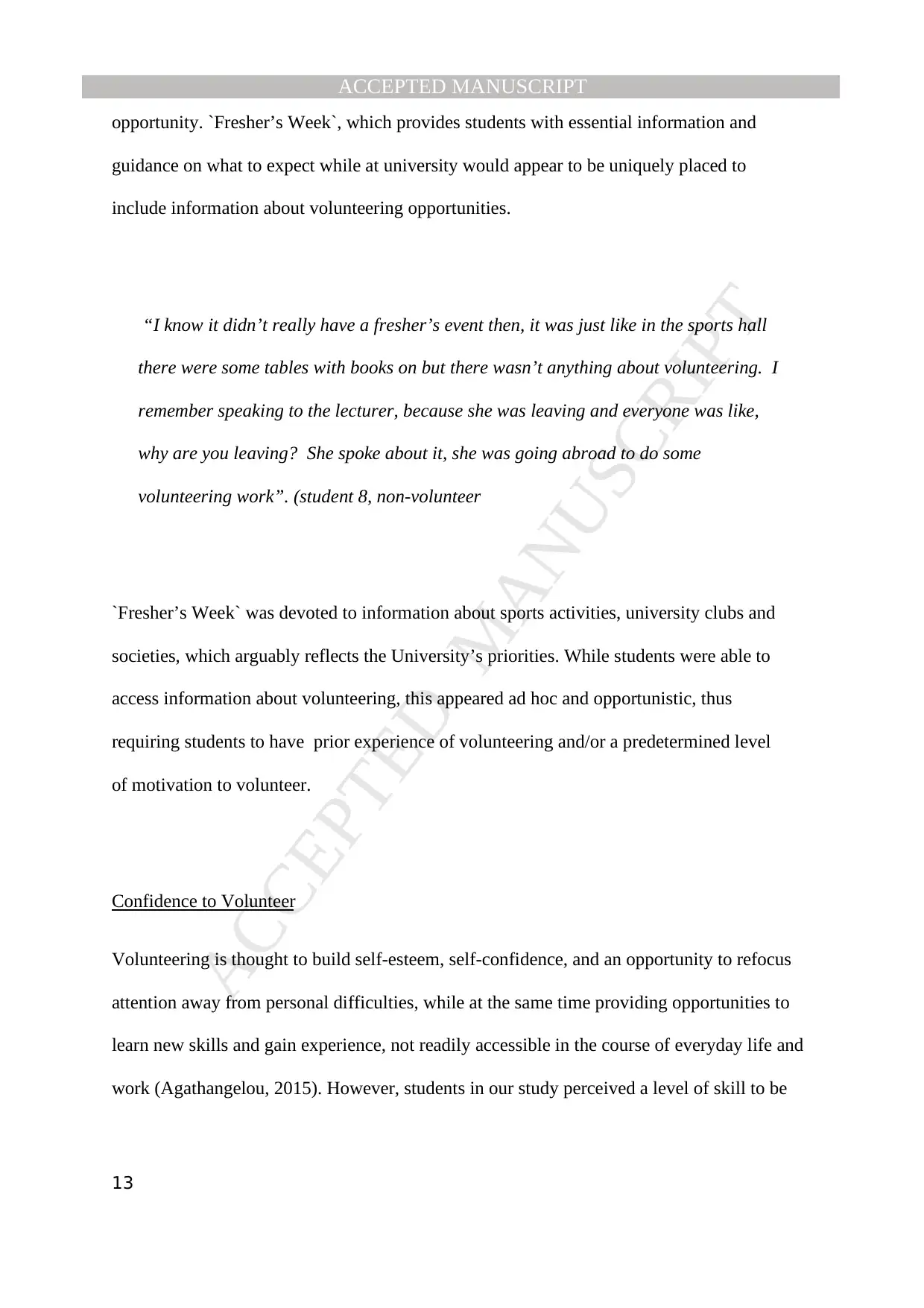
MANUSCRIPTACCEPTED
ACCEPTED MANUSCRIPT
13
opportunity. `Fresher’s Week`, which provides students with essential information and
guidance on what to expect while at university would appear to be uniquely placed to
include information about volunteering opportunities.
“I know it didn’t really have a fresher’s event then, it was just like in the sports hall
there were some tables with books on but there wasn’t anything about volunteering. I
remember speaking to the lecturer, because she was leaving and everyone was like,
why are you leaving? She spoke about it, she was going abroad to do some
volunteering work”. (student 8, non-volunteer
`Fresher’s Week` was devoted to information about sports activities, university clubs and
societies, which arguably reflects the University’s priorities. While students were able to
access information about volunteering, this appeared ad hoc and opportunistic, thus
requiring students to have prior experience of volunteering and/or a predetermined level
of motivation to volunteer.
Confidence to Volunteer
Volunteering is thought to build self-esteem, self-confidence, and an opportunity to refocus
attention away from personal difficulties, while at the same time providing opportunities to
learn new skills and gain experience, not readily accessible in the course of everyday life and
work (Agathangelou, 2015). However, students in our study perceived a level of skill to be
ACCEPTED MANUSCRIPT
13
opportunity. `Fresher’s Week`, which provides students with essential information and
guidance on what to expect while at university would appear to be uniquely placed to
include information about volunteering opportunities.
“I know it didn’t really have a fresher’s event then, it was just like in the sports hall
there were some tables with books on but there wasn’t anything about volunteering. I
remember speaking to the lecturer, because she was leaving and everyone was like,
why are you leaving? She spoke about it, she was going abroad to do some
volunteering work”. (student 8, non-volunteer
`Fresher’s Week` was devoted to information about sports activities, university clubs and
societies, which arguably reflects the University’s priorities. While students were able to
access information about volunteering, this appeared ad hoc and opportunistic, thus
requiring students to have prior experience of volunteering and/or a predetermined level
of motivation to volunteer.
Confidence to Volunteer
Volunteering is thought to build self-esteem, self-confidence, and an opportunity to refocus
attention away from personal difficulties, while at the same time providing opportunities to
learn new skills and gain experience, not readily accessible in the course of everyday life and
work (Agathangelou, 2015). However, students in our study perceived a level of skill to be
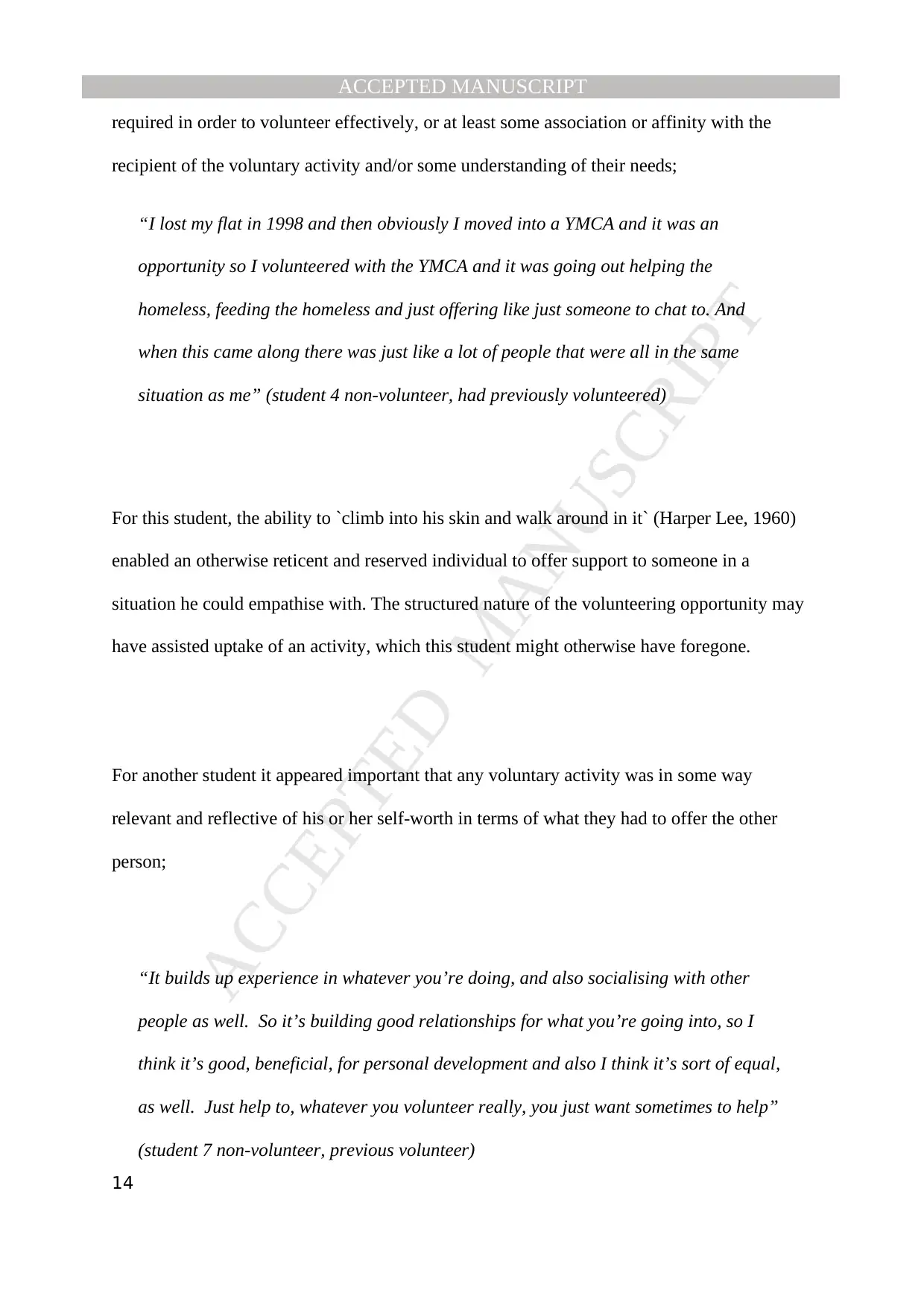
MANUSCRIPTACCEPTED
ACCEPTED MANUSCRIPT
14
required in order to volunteer effectively, or at least some association or affinity with the
recipient of the voluntary activity and/or some understanding of their needs;
“I lost my flat in 1998 and then obviously I moved into a YMCA and it was an
opportunity so I volunteered with the YMCA and it was going out helping the
homeless, feeding the homeless and just offering like just someone to chat to. And
when this came along there was just like a lot of people that were all in the same
situation as me” (student 4 non-volunteer, had previously volunteered)
For this student, the ability to `climb into his skin and walk around in it` (Harper Lee, 1960)
enabled an otherwise reticent and reserved individual to offer support to someone in a
situation he could empathise with. The structured nature of the volunteering opportunity may
have assisted uptake of an activity, which this student might otherwise have foregone.
For another student it appeared important that any voluntary activity was in some way
relevant and reflective of his or her self-worth in terms of what they had to offer the other
person;
“It builds up experience in whatever you’re doing, and also socialising with other
people as well. So it’s building good relationships for what you’re going into, so I
think it’s good, beneficial, for personal development and also I think it’s sort of equal,
as well. Just help to, whatever you volunteer really, you just want sometimes to help”
(student 7 non-volunteer, previous volunteer)
ACCEPTED MANUSCRIPT
14
required in order to volunteer effectively, or at least some association or affinity with the
recipient of the voluntary activity and/or some understanding of their needs;
“I lost my flat in 1998 and then obviously I moved into a YMCA and it was an
opportunity so I volunteered with the YMCA and it was going out helping the
homeless, feeding the homeless and just offering like just someone to chat to. And
when this came along there was just like a lot of people that were all in the same
situation as me” (student 4 non-volunteer, had previously volunteered)
For this student, the ability to `climb into his skin and walk around in it` (Harper Lee, 1960)
enabled an otherwise reticent and reserved individual to offer support to someone in a
situation he could empathise with. The structured nature of the volunteering opportunity may
have assisted uptake of an activity, which this student might otherwise have foregone.
For another student it appeared important that any voluntary activity was in some way
relevant and reflective of his or her self-worth in terms of what they had to offer the other
person;
“It builds up experience in whatever you’re doing, and also socialising with other
people as well. So it’s building good relationships for what you’re going into, so I
think it’s good, beneficial, for personal development and also I think it’s sort of equal,
as well. Just help to, whatever you volunteer really, you just want sometimes to help”
(student 7 non-volunteer, previous volunteer)
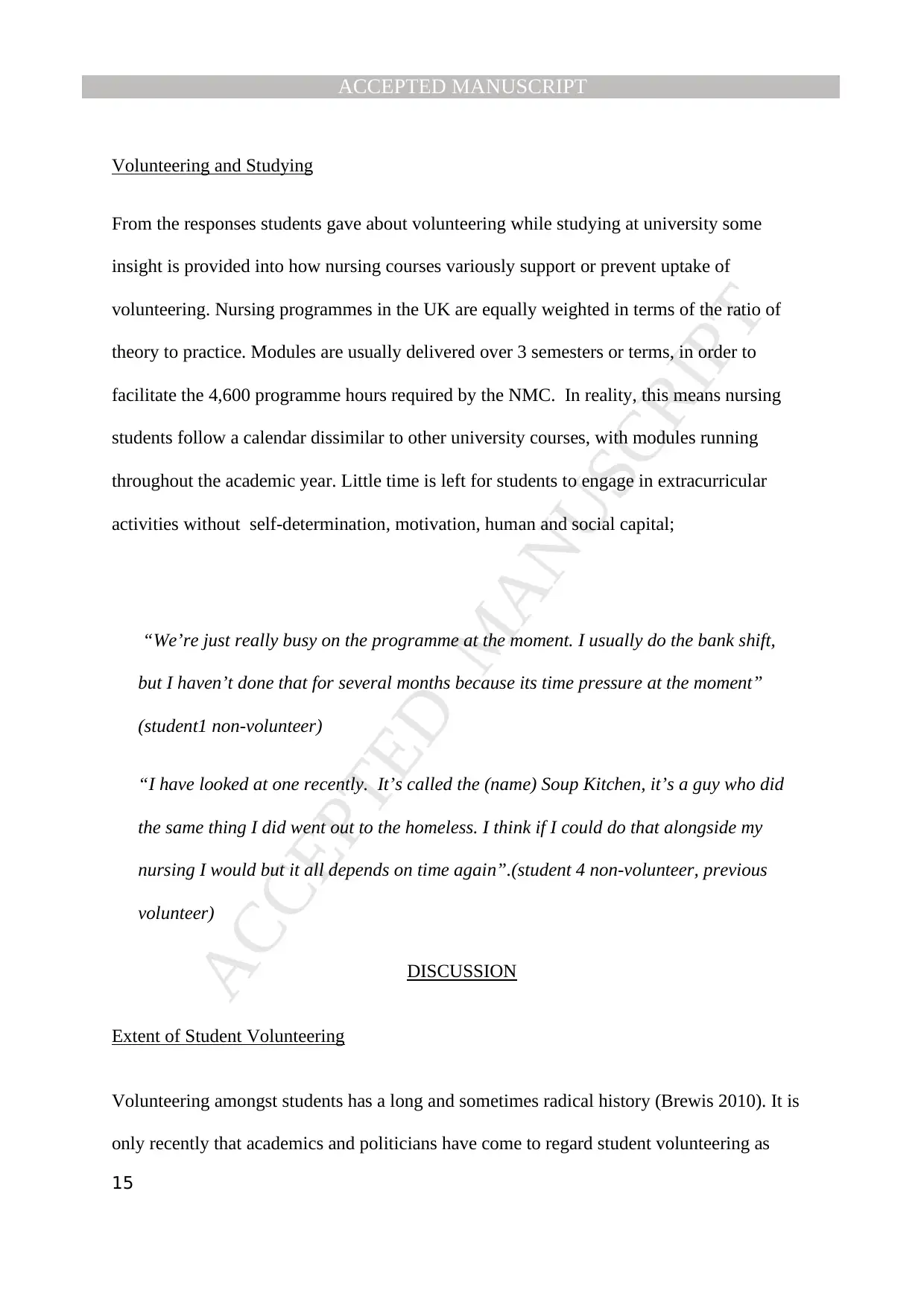
MANUSCRIPTACCEPTED
ACCEPTED MANUSCRIPT
15
Volunteering and Studying
From the responses students gave about volunteering while studying at university some
insight is provided into how nursing courses variously support or prevent uptake of
volunteering. Nursing programmes in the UK are equally weighted in terms of the ratio of
theory to practice. Modules are usually delivered over 3 semesters or terms, in order to
facilitate the 4,600 programme hours required by the NMC. In reality, this means nursing
students follow a calendar dissimilar to other university courses, with modules running
throughout the academic year. Little time is left for students to engage in extracurricular
activities without self-determination, motivation, human and social capital;
“We’re just really busy on the programme at the moment. I usually do the bank shift,
but I haven’t done that for several months because its time pressure at the moment”
(student1 non-volunteer)
“I have looked at one recently. It’s called the (name) Soup Kitchen, it’s a guy who did
the same thing I did went out to the homeless. I think if I could do that alongside my
nursing I would but it all depends on time again”.(student 4 non-volunteer, previous
volunteer)
DISCUSSION
Extent of Student Volunteering
Volunteering amongst students has a long and sometimes radical history (Brewis 2010). It is
only recently that academics and politicians have come to regard student volunteering as
ACCEPTED MANUSCRIPT
15
Volunteering and Studying
From the responses students gave about volunteering while studying at university some
insight is provided into how nursing courses variously support or prevent uptake of
volunteering. Nursing programmes in the UK are equally weighted in terms of the ratio of
theory to practice. Modules are usually delivered over 3 semesters or terms, in order to
facilitate the 4,600 programme hours required by the NMC. In reality, this means nursing
students follow a calendar dissimilar to other university courses, with modules running
throughout the academic year. Little time is left for students to engage in extracurricular
activities without self-determination, motivation, human and social capital;
“We’re just really busy on the programme at the moment. I usually do the bank shift,
but I haven’t done that for several months because its time pressure at the moment”
(student1 non-volunteer)
“I have looked at one recently. It’s called the (name) Soup Kitchen, it’s a guy who did
the same thing I did went out to the homeless. I think if I could do that alongside my
nursing I would but it all depends on time again”.(student 4 non-volunteer, previous
volunteer)
DISCUSSION
Extent of Student Volunteering
Volunteering amongst students has a long and sometimes radical history (Brewis 2010). It is
only recently that academics and politicians have come to regard student volunteering as
Paraphrase This Document
Need a fresh take? Get an instant paraphrase of this document with our AI Paraphraser
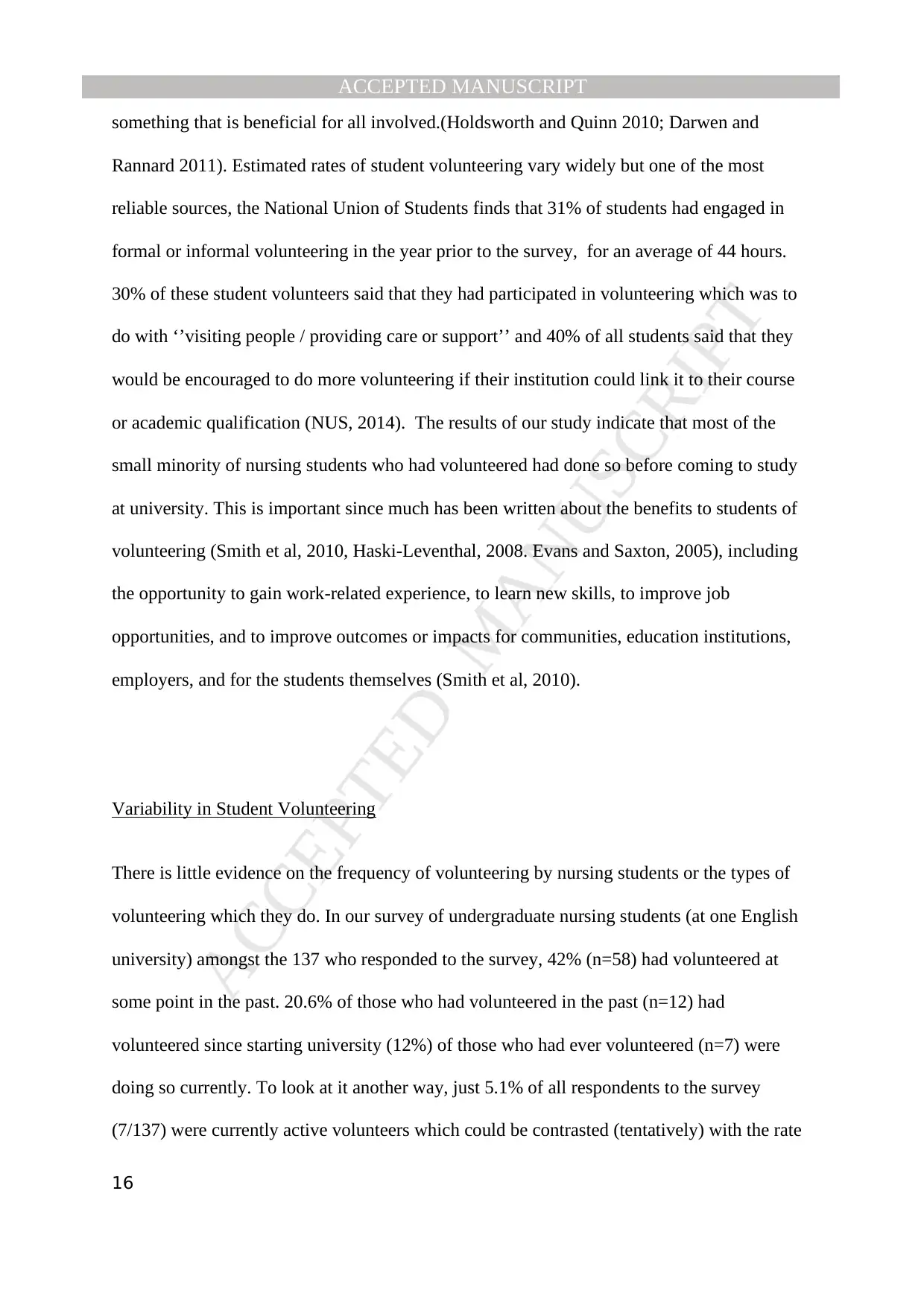
MANUSCRIPTACCEPTED
ACCEPTED MANUSCRIPT
16
something that is beneficial for all involved.(Holdsworth and Quinn 2010; Darwen and
Rannard 2011). Estimated rates of student volunteering vary widely but one of the most
reliable sources, the National Union of Students finds that 31% of students had engaged in
formal or informal volunteering in the year prior to the survey, for an average of 44 hours.
30% of these student volunteers said that they had participated in volunteering which was to
do with ‘’visiting people / providing care or support’’ and 40% of all students said that they
would be encouraged to do more volunteering if their institution could link it to their course
or academic qualification (NUS, 2014). The results of our study indicate that most of the
small minority of nursing students who had volunteered had done so before coming to study
at university. This is important since much has been written about the benefits to students of
volunteering (Smith et al, 2010, Haski-Leventhal, 2008. Evans and Saxton, 2005), including
the opportunity to gain work-related experience, to learn new skills, to improve job
opportunities, and to improve outcomes or impacts for communities, education institutions,
employers, and for the students themselves (Smith et al, 2010).
Variability in Student Volunteering
There is little evidence on the frequency of volunteering by nursing students or the types of
volunteering which they do. In our survey of undergraduate nursing students (at one English
university) amongst the 137 who responded to the survey, 42% (n=58) had volunteered at
some point in the past. 20.6% of those who had volunteered in the past (n=12) had
volunteered since starting university (12%) of those who had ever volunteered (n=7) were
doing so currently. To look at it another way, just 5.1% of all respondents to the survey
(7/137) were currently active volunteers which could be contrasted (tentatively) with the rate
ACCEPTED MANUSCRIPT
16
something that is beneficial for all involved.(Holdsworth and Quinn 2010; Darwen and
Rannard 2011). Estimated rates of student volunteering vary widely but one of the most
reliable sources, the National Union of Students finds that 31% of students had engaged in
formal or informal volunteering in the year prior to the survey, for an average of 44 hours.
30% of these student volunteers said that they had participated in volunteering which was to
do with ‘’visiting people / providing care or support’’ and 40% of all students said that they
would be encouraged to do more volunteering if their institution could link it to their course
or academic qualification (NUS, 2014). The results of our study indicate that most of the
small minority of nursing students who had volunteered had done so before coming to study
at university. This is important since much has been written about the benefits to students of
volunteering (Smith et al, 2010, Haski-Leventhal, 2008. Evans and Saxton, 2005), including
the opportunity to gain work-related experience, to learn new skills, to improve job
opportunities, and to improve outcomes or impacts for communities, education institutions,
employers, and for the students themselves (Smith et al, 2010).
Variability in Student Volunteering
There is little evidence on the frequency of volunteering by nursing students or the types of
volunteering which they do. In our survey of undergraduate nursing students (at one English
university) amongst the 137 who responded to the survey, 42% (n=58) had volunteered at
some point in the past. 20.6% of those who had volunteered in the past (n=12) had
volunteered since starting university (12%) of those who had ever volunteered (n=7) were
doing so currently. To look at it another way, just 5.1% of all respondents to the survey
(7/137) were currently active volunteers which could be contrasted (tentatively) with the rate
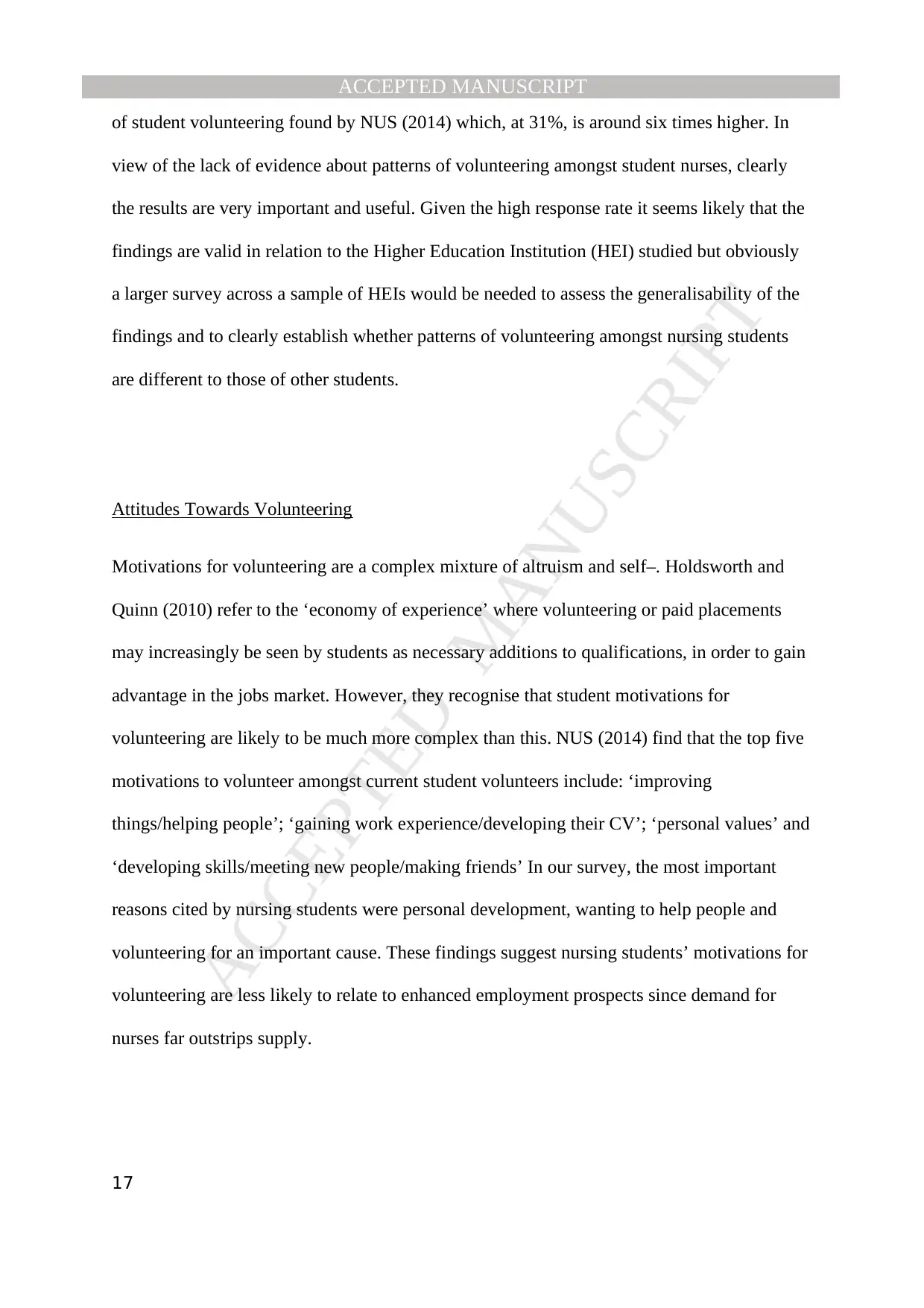
MANUSCRIPTACCEPTED
ACCEPTED MANUSCRIPT
17
of student volunteering found by NUS (2014) which, at 31%, is around six times higher. In
view of the lack of evidence about patterns of volunteering amongst student nurses, clearly
the results are very important and useful. Given the high response rate it seems likely that the
findings are valid in relation to the Higher Education Institution (HEI) studied but obviously
a larger survey across a sample of HEIs would be needed to assess the generalisability of the
findings and to clearly establish whether patterns of volunteering amongst nursing students
are different to those of other students.
Attitudes Towards Volunteering
Motivations for volunteering are a complex mixture of altruism and self–. Holdsworth and
Quinn (2010) refer to the ‘economy of experience’ where volunteering or paid placements
may increasingly be seen by students as necessary additions to qualifications, in order to gain
advantage in the jobs market. However, they recognise that student motivations for
volunteering are likely to be much more complex than this. NUS (2014) find that the top five
motivations to volunteer amongst current student volunteers include: ‘improving
things/helping people’; ‘gaining work experience/developing their CV’; ‘personal values’ and
‘developing skills/meeting new people/making friends’ In our survey, the most important
reasons cited by nursing students were personal development, wanting to help people and
volunteering for an important cause. These findings suggest nursing students’ motivations for
volunteering are less likely to relate to enhanced employment prospects since demand for
nurses far outstrips supply.
ACCEPTED MANUSCRIPT
17
of student volunteering found by NUS (2014) which, at 31%, is around six times higher. In
view of the lack of evidence about patterns of volunteering amongst student nurses, clearly
the results are very important and useful. Given the high response rate it seems likely that the
findings are valid in relation to the Higher Education Institution (HEI) studied but obviously
a larger survey across a sample of HEIs would be needed to assess the generalisability of the
findings and to clearly establish whether patterns of volunteering amongst nursing students
are different to those of other students.
Attitudes Towards Volunteering
Motivations for volunteering are a complex mixture of altruism and self–. Holdsworth and
Quinn (2010) refer to the ‘economy of experience’ where volunteering or paid placements
may increasingly be seen by students as necessary additions to qualifications, in order to gain
advantage in the jobs market. However, they recognise that student motivations for
volunteering are likely to be much more complex than this. NUS (2014) find that the top five
motivations to volunteer amongst current student volunteers include: ‘improving
things/helping people’; ‘gaining work experience/developing their CV’; ‘personal values’ and
‘developing skills/meeting new people/making friends’ In our survey, the most important
reasons cited by nursing students were personal development, wanting to help people and
volunteering for an important cause. These findings suggest nursing students’ motivations for
volunteering are less likely to relate to enhanced employment prospects since demand for
nurses far outstrips supply.
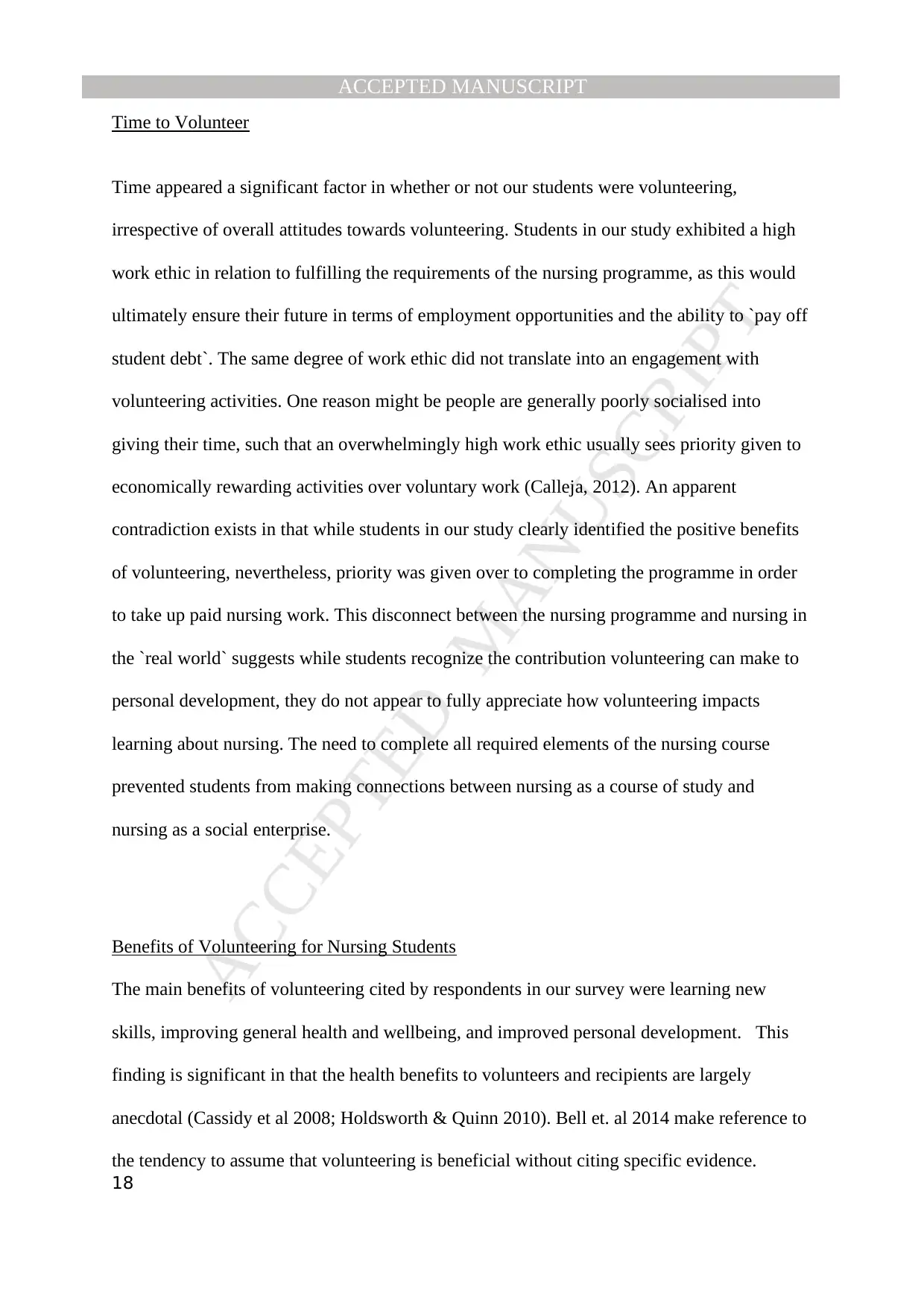
MANUSCRIPTACCEPTED
ACCEPTED MANUSCRIPT
18
Time to Volunteer
Time appeared a significant factor in whether or not our students were volunteering,
irrespective of overall attitudes towards volunteering. Students in our study exhibited a high
work ethic in relation to fulfilling the requirements of the nursing programme, as this would
ultimately ensure their future in terms of employment opportunities and the ability to `pay off
student debt`. The same degree of work ethic did not translate into an engagement with
volunteering activities. One reason might be people are generally poorly socialised into
giving their time, such that an overwhelmingly high work ethic usually sees priority given to
economically rewarding activities over voluntary work (Calleja, 2012). An apparent
contradiction exists in that while students in our study clearly identified the positive benefits
of volunteering, nevertheless, priority was given over to completing the programme in order
to take up paid nursing work. This disconnect between the nursing programme and nursing in
the `real world` suggests while students recognize the contribution volunteering can make to
personal development, they do not appear to fully appreciate how volunteering impacts
learning about nursing. The need to complete all required elements of the nursing course
prevented students from making connections between nursing as a course of study and
nursing as a social enterprise.
Benefits of Volunteering for Nursing Students
The main benefits of volunteering cited by respondents in our survey were learning new
skills, improving general health and wellbeing, and improved personal development. This
finding is significant in that the health benefits to volunteers and recipients are largely
anecdotal (Cassidy et al 2008; Holdsworth & Quinn 2010). Bell et. al 2014 make reference to
the tendency to assume that volunteering is beneficial without citing specific evidence.
ACCEPTED MANUSCRIPT
18
Time to Volunteer
Time appeared a significant factor in whether or not our students were volunteering,
irrespective of overall attitudes towards volunteering. Students in our study exhibited a high
work ethic in relation to fulfilling the requirements of the nursing programme, as this would
ultimately ensure their future in terms of employment opportunities and the ability to `pay off
student debt`. The same degree of work ethic did not translate into an engagement with
volunteering activities. One reason might be people are generally poorly socialised into
giving their time, such that an overwhelmingly high work ethic usually sees priority given to
economically rewarding activities over voluntary work (Calleja, 2012). An apparent
contradiction exists in that while students in our study clearly identified the positive benefits
of volunteering, nevertheless, priority was given over to completing the programme in order
to take up paid nursing work. This disconnect between the nursing programme and nursing in
the `real world` suggests while students recognize the contribution volunteering can make to
personal development, they do not appear to fully appreciate how volunteering impacts
learning about nursing. The need to complete all required elements of the nursing course
prevented students from making connections between nursing as a course of study and
nursing as a social enterprise.
Benefits of Volunteering for Nursing Students
The main benefits of volunteering cited by respondents in our survey were learning new
skills, improving general health and wellbeing, and improved personal development. This
finding is significant in that the health benefits to volunteers and recipients are largely
anecdotal (Cassidy et al 2008; Holdsworth & Quinn 2010). Bell et. al 2014 make reference to
the tendency to assume that volunteering is beneficial without citing specific evidence.
Secure Best Marks with AI Grader
Need help grading? Try our AI Grader for instant feedback on your assignments.

MANUSCRIPTACCEPTED
ACCEPTED MANUSCRIPT
19
Positive learning emerges from a situation predicated upon equality of social relations (Boeck
et al, 2009). This is very important as nursing students and nurses are embedded in a series of
nested and inter-penetrating hierarchies, including both subordinated roles (lecturer-student;
ward manager-nurse; ward manager-nursing student; doctor-nurse) and roles where, although
they may not reflect on the fact, they are generally in the superordinate position
(professional-client; nurse-health care assistant; nurse-nurse student). It would therefore seem
that volunteering, as well as providing opportunities to increase skills, confidence and
empathy, also contain a hidden curriculum message, namely that the learning process benefits
from an equalization of power, and thus has implications for how nurses, nurse tutors and
nursing managers, conduct themselves when in superordinate positions. While student
volunteering may not automatically result in leaning, nor directly link to the development of
caring and compassionate practice, nonetheless volunteering does provide a way for students
to make sense of their experiences through opportunities intentionally designed to foster
critical thinking.
Implications for Nurse Education
Nursing students share many of these characteristics associated with increased volunteering
but the limited evidence available suggests that they have very low rates of volunteering
compared to the student average and this may be in part attributable to the structure of
nursing programmes, which allows little free time compared to other undergraduate
programmes. The abolition of bursaries for students nurses from 2017 may increase the
amount of paid work undertaken by student nurses and thus further limit volunteering,
ACCEPTED MANUSCRIPT
19
Positive learning emerges from a situation predicated upon equality of social relations (Boeck
et al, 2009). This is very important as nursing students and nurses are embedded in a series of
nested and inter-penetrating hierarchies, including both subordinated roles (lecturer-student;
ward manager-nurse; ward manager-nursing student; doctor-nurse) and roles where, although
they may not reflect on the fact, they are generally in the superordinate position
(professional-client; nurse-health care assistant; nurse-nurse student). It would therefore seem
that volunteering, as well as providing opportunities to increase skills, confidence and
empathy, also contain a hidden curriculum message, namely that the learning process benefits
from an equalization of power, and thus has implications for how nurses, nurse tutors and
nursing managers, conduct themselves when in superordinate positions. While student
volunteering may not automatically result in leaning, nor directly link to the development of
caring and compassionate practice, nonetheless volunteering does provide a way for students
to make sense of their experiences through opportunities intentionally designed to foster
critical thinking.
Implications for Nurse Education
Nursing students share many of these characteristics associated with increased volunteering
but the limited evidence available suggests that they have very low rates of volunteering
compared to the student average and this may be in part attributable to the structure of
nursing programmes, which allows little free time compared to other undergraduate
programmes. The abolition of bursaries for students nurses from 2017 may increase the
amount of paid work undertaken by student nurses and thus further limit volunteering,
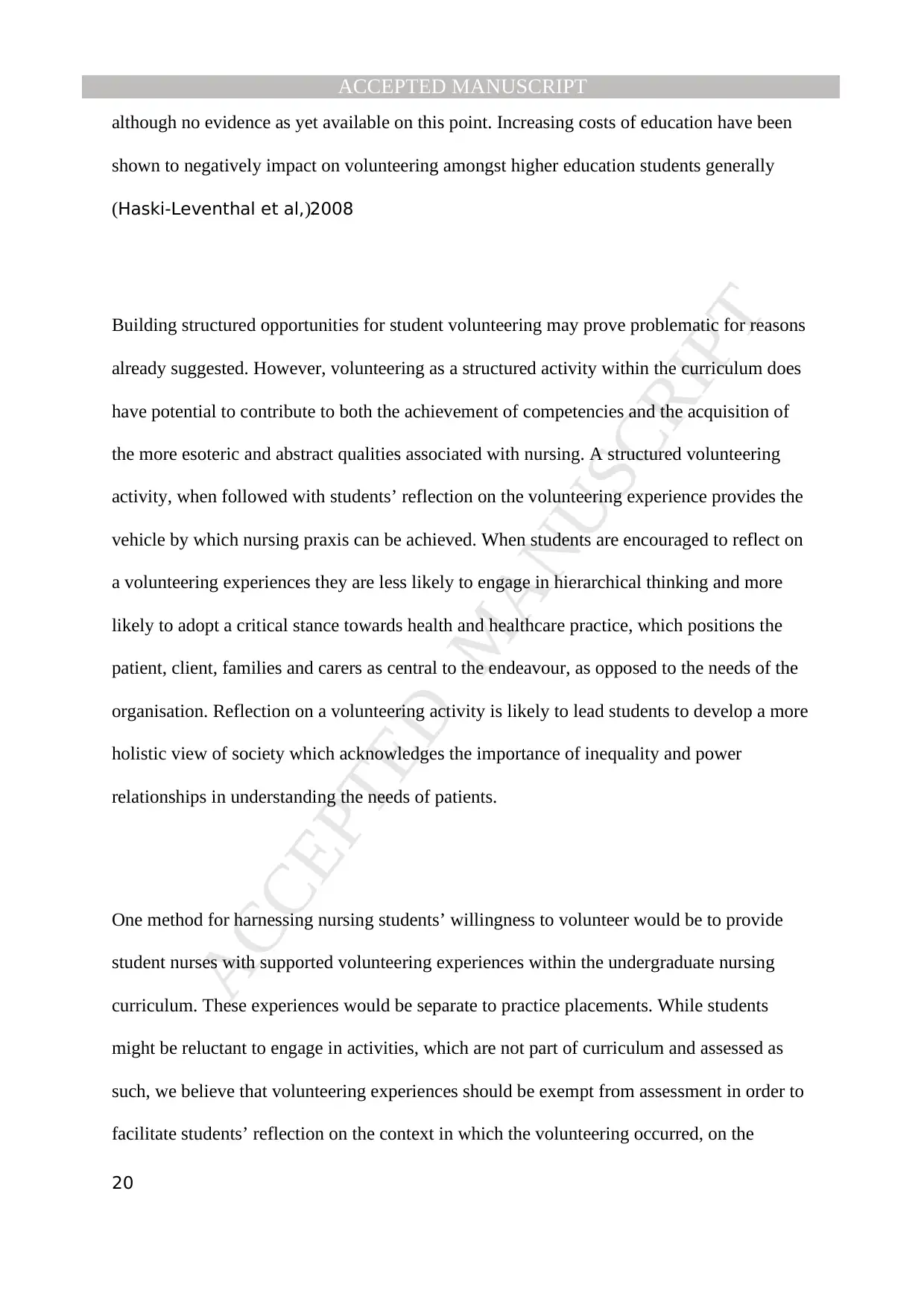
MANUSCRIPTACCEPTED
ACCEPTED MANUSCRIPT
20
although no evidence as yet available on this point. Increasing costs of education have been
shown to negatively impact on volunteering amongst higher education students generally
(Haski-Leventhal et al, 2008).
Building structured opportunities for student volunteering may prove problematic for reasons
already suggested. However, volunteering as a structured activity within the curriculum does
have potential to contribute to both the achievement of competencies and the acquisition of
the more esoteric and abstract qualities associated with nursing. A structured volunteering
activity, when followed with students’ reflection on the volunteering experience provides the
vehicle by which nursing praxis can be achieved. When students are encouraged to reflect on
a volunteering experiences they are less likely to engage in hierarchical thinking and more
likely to adopt a critical stance towards health and healthcare practice, which positions the
patient, client, families and carers as central to the endeavour, as opposed to the needs of the
organisation. Reflection on a volunteering activity is likely to lead students to develop a more
holistic view of society which acknowledges the importance of inequality and power
relationships in understanding the needs of patients.
One method for harnessing nursing students’ willingness to volunteer would be to provide
student nurses with supported volunteering experiences within the undergraduate nursing
curriculum. These experiences would be separate to practice placements. While students
might be reluctant to engage in activities, which are not part of curriculum and assessed as
such, we believe that volunteering experiences should be exempt from assessment in order to
facilitate students’ reflection on the context in which the volunteering occurred, on the
ACCEPTED MANUSCRIPT
20
although no evidence as yet available on this point. Increasing costs of education have been
shown to negatively impact on volunteering amongst higher education students generally
(Haski-Leventhal et al, 2008).
Building structured opportunities for student volunteering may prove problematic for reasons
already suggested. However, volunteering as a structured activity within the curriculum does
have potential to contribute to both the achievement of competencies and the acquisition of
the more esoteric and abstract qualities associated with nursing. A structured volunteering
activity, when followed with students’ reflection on the volunteering experience provides the
vehicle by which nursing praxis can be achieved. When students are encouraged to reflect on
a volunteering experiences they are less likely to engage in hierarchical thinking and more
likely to adopt a critical stance towards health and healthcare practice, which positions the
patient, client, families and carers as central to the endeavour, as opposed to the needs of the
organisation. Reflection on a volunteering activity is likely to lead students to develop a more
holistic view of society which acknowledges the importance of inequality and power
relationships in understanding the needs of patients.
One method for harnessing nursing students’ willingness to volunteer would be to provide
student nurses with supported volunteering experiences within the undergraduate nursing
curriculum. These experiences would be separate to practice placements. While students
might be reluctant to engage in activities, which are not part of curriculum and assessed as
such, we believe that volunteering experiences should be exempt from assessment in order to
facilitate students’ reflection on the context in which the volunteering occurred, on the
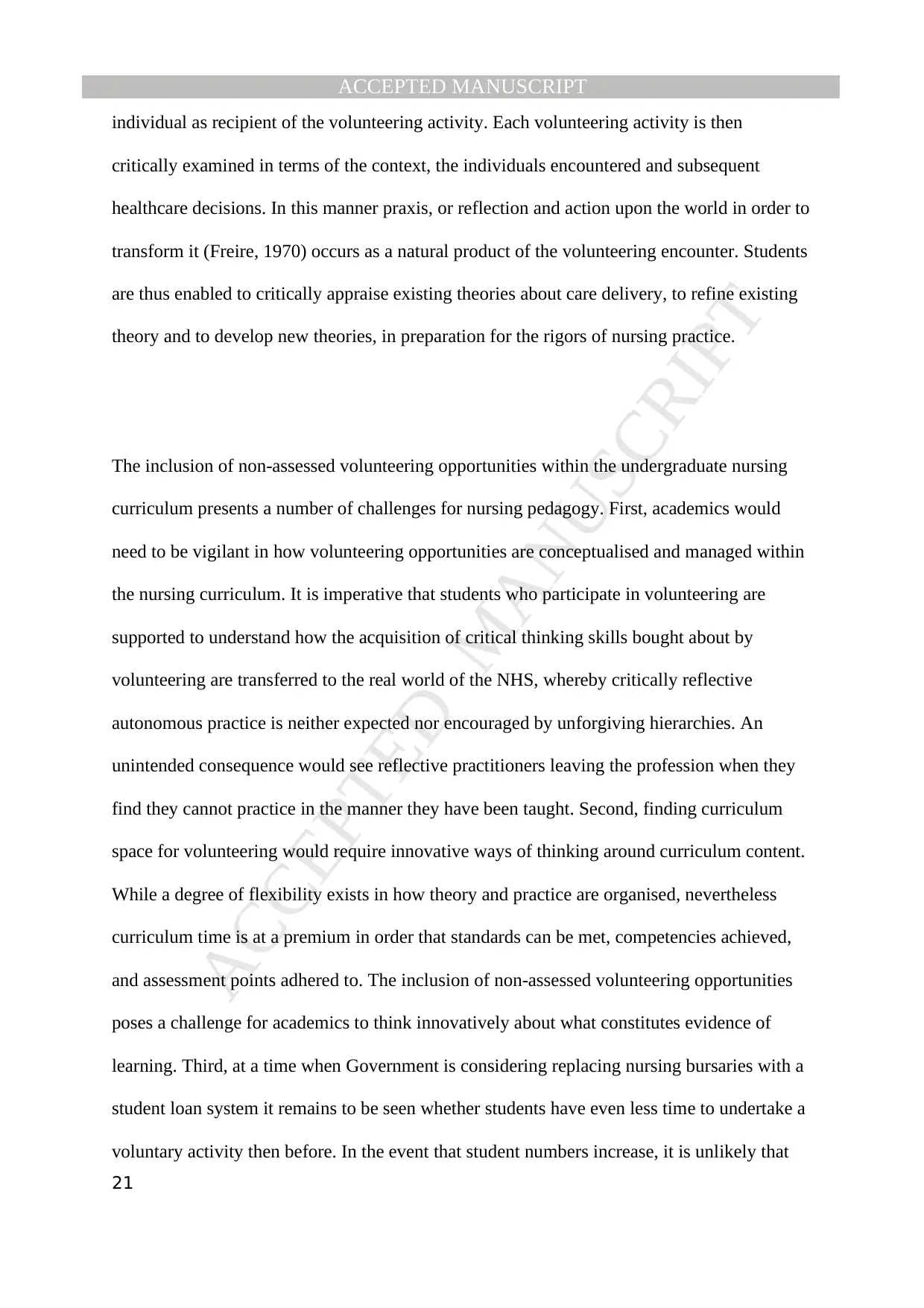
MANUSCRIPTACCEPTED
ACCEPTED MANUSCRIPT
21
individual as recipient of the volunteering activity. Each volunteering activity is then
critically examined in terms of the context, the individuals encountered and subsequent
healthcare decisions. In this manner praxis, or reflection and action upon the world in order to
transform it (Freire, 1970) occurs as a natural product of the volunteering encounter. Students
are thus enabled to critically appraise existing theories about care delivery, to refine existing
theory and to develop new theories, in preparation for the rigors of nursing practice.
The inclusion of non-assessed volunteering opportunities within the undergraduate nursing
curriculum presents a number of challenges for nursing pedagogy. First, academics would
need to be vigilant in how volunteering opportunities are conceptualised and managed within
the nursing curriculum. It is imperative that students who participate in volunteering are
supported to understand how the acquisition of critical thinking skills bought about by
volunteering are transferred to the real world of the NHS, whereby critically reflective
autonomous practice is neither expected nor encouraged by unforgiving hierarchies. An
unintended consequence would see reflective practitioners leaving the profession when they
find they cannot practice in the manner they have been taught. Second, finding curriculum
space for volunteering would require innovative ways of thinking around curriculum content.
While a degree of flexibility exists in how theory and practice are organised, nevertheless
curriculum time is at a premium in order that standards can be met, competencies achieved,
and assessment points adhered to. The inclusion of non-assessed volunteering opportunities
poses a challenge for academics to think innovatively about what constitutes evidence of
learning. Third, at a time when Government is considering replacing nursing bursaries with a
student loan system it remains to be seen whether students have even less time to undertake a
voluntary activity then before. In the event that student numbers increase, it is unlikely that
ACCEPTED MANUSCRIPT
21
individual as recipient of the volunteering activity. Each volunteering activity is then
critically examined in terms of the context, the individuals encountered and subsequent
healthcare decisions. In this manner praxis, or reflection and action upon the world in order to
transform it (Freire, 1970) occurs as a natural product of the volunteering encounter. Students
are thus enabled to critically appraise existing theories about care delivery, to refine existing
theory and to develop new theories, in preparation for the rigors of nursing practice.
The inclusion of non-assessed volunteering opportunities within the undergraduate nursing
curriculum presents a number of challenges for nursing pedagogy. First, academics would
need to be vigilant in how volunteering opportunities are conceptualised and managed within
the nursing curriculum. It is imperative that students who participate in volunteering are
supported to understand how the acquisition of critical thinking skills bought about by
volunteering are transferred to the real world of the NHS, whereby critically reflective
autonomous practice is neither expected nor encouraged by unforgiving hierarchies. An
unintended consequence would see reflective practitioners leaving the profession when they
find they cannot practice in the manner they have been taught. Second, finding curriculum
space for volunteering would require innovative ways of thinking around curriculum content.
While a degree of flexibility exists in how theory and practice are organised, nevertheless
curriculum time is at a premium in order that standards can be met, competencies achieved,
and assessment points adhered to. The inclusion of non-assessed volunteering opportunities
poses a challenge for academics to think innovatively about what constitutes evidence of
learning. Third, at a time when Government is considering replacing nursing bursaries with a
student loan system it remains to be seen whether students have even less time to undertake a
voluntary activity then before. In the event that student numbers increase, it is unlikely that
Paraphrase This Document
Need a fresh take? Get an instant paraphrase of this document with our AI Paraphraser
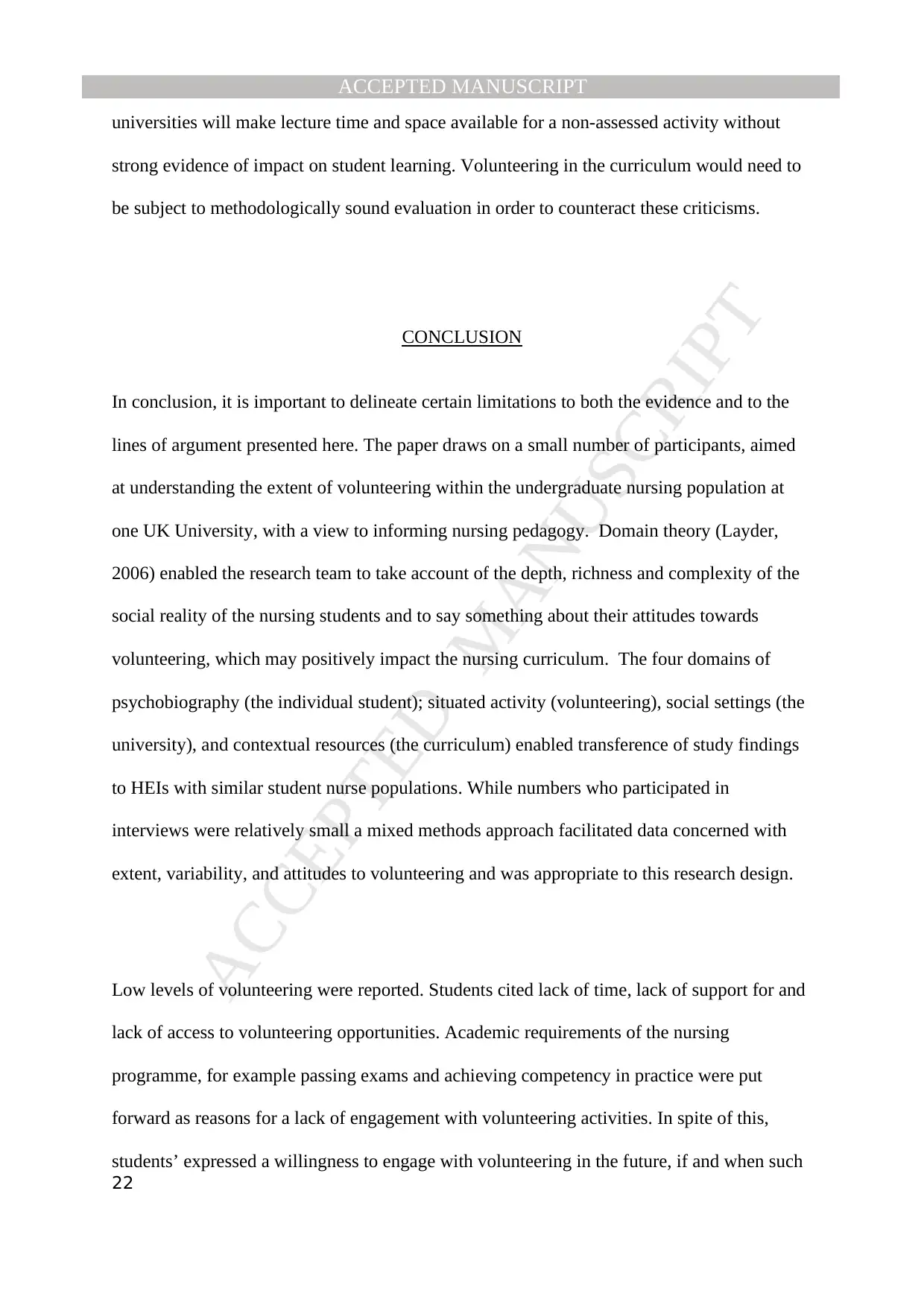
MANUSCRIPTACCEPTED
ACCEPTED MANUSCRIPT
22
universities will make lecture time and space available for a non-assessed activity without
strong evidence of impact on student learning. Volunteering in the curriculum would need to
be subject to methodologically sound evaluation in order to counteract these criticisms.
CONCLUSION
In conclusion, it is important to delineate certain limitations to both the evidence and to the
lines of argument presented here. The paper draws on a small number of participants, aimed
at understanding the extent of volunteering within the undergraduate nursing population at
one UK University, with a view to informing nursing pedagogy. Domain theory (Layder,
2006) enabled the research team to take account of the depth, richness and complexity of the
social reality of the nursing students and to say something about their attitudes towards
volunteering, which may positively impact the nursing curriculum. The four domains of
psychobiography (the individual student); situated activity (volunteering), social settings (the
university), and contextual resources (the curriculum) enabled transference of study findings
to HEIs with similar student nurse populations. While numbers who participated in
interviews were relatively small a mixed methods approach facilitated data concerned with
extent, variability, and attitudes to volunteering and was appropriate to this research design.
Low levels of volunteering were reported. Students cited lack of time, lack of support for and
lack of access to volunteering opportunities. Academic requirements of the nursing
programme, for example passing exams and achieving competency in practice were put
forward as reasons for a lack of engagement with volunteering activities. In spite of this,
students’ expressed a willingness to engage with volunteering in the future, if and when such
ACCEPTED MANUSCRIPT
22
universities will make lecture time and space available for a non-assessed activity without
strong evidence of impact on student learning. Volunteering in the curriculum would need to
be subject to methodologically sound evaluation in order to counteract these criticisms.
CONCLUSION
In conclusion, it is important to delineate certain limitations to both the evidence and to the
lines of argument presented here. The paper draws on a small number of participants, aimed
at understanding the extent of volunteering within the undergraduate nursing population at
one UK University, with a view to informing nursing pedagogy. Domain theory (Layder,
2006) enabled the research team to take account of the depth, richness and complexity of the
social reality of the nursing students and to say something about their attitudes towards
volunteering, which may positively impact the nursing curriculum. The four domains of
psychobiography (the individual student); situated activity (volunteering), social settings (the
university), and contextual resources (the curriculum) enabled transference of study findings
to HEIs with similar student nurse populations. While numbers who participated in
interviews were relatively small a mixed methods approach facilitated data concerned with
extent, variability, and attitudes to volunteering and was appropriate to this research design.
Low levels of volunteering were reported. Students cited lack of time, lack of support for and
lack of access to volunteering opportunities. Academic requirements of the nursing
programme, for example passing exams and achieving competency in practice were put
forward as reasons for a lack of engagement with volunteering activities. In spite of this,
students’ expressed a willingness to engage with volunteering in the future, if and when such
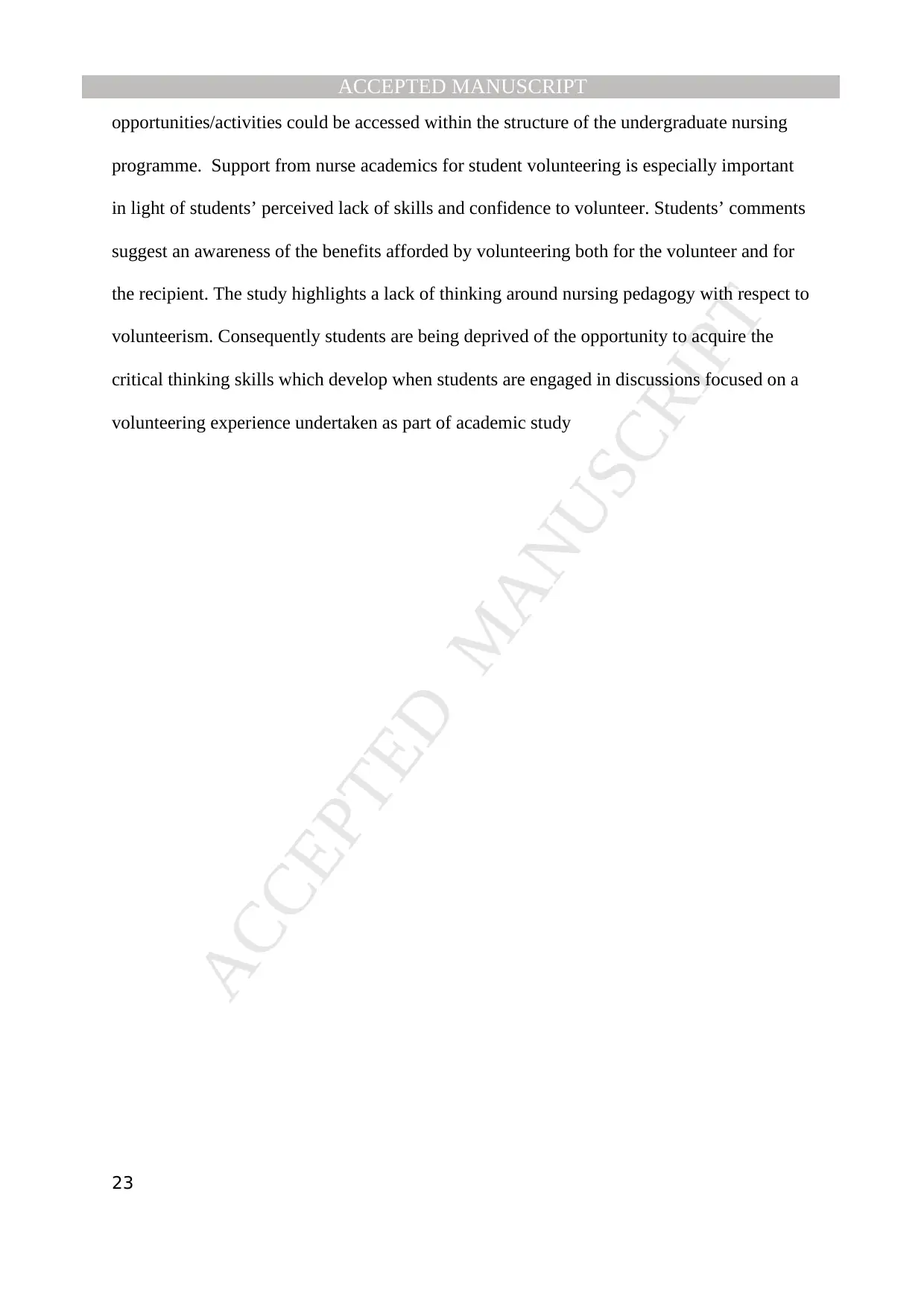
MANUSCRIPTACCEPTED
ACCEPTED MANUSCRIPT
23
opportunities/activities could be accessed within the structure of the undergraduate nursing
programme. Support from nurse academics for student volunteering is especially important
in light of students’ perceived lack of skills and confidence to volunteer. Students’ comments
suggest an awareness of the benefits afforded by volunteering both for the volunteer and for
the recipient. The study highlights a lack of thinking around nursing pedagogy with respect to
volunteerism. Consequently students are being deprived of the opportunity to acquire the
critical thinking skills which develop when students are engaged in discussions focused on a
volunteering experience undertaken as part of academic study
ACCEPTED MANUSCRIPT
23
opportunities/activities could be accessed within the structure of the undergraduate nursing
programme. Support from nurse academics for student volunteering is especially important
in light of students’ perceived lack of skills and confidence to volunteer. Students’ comments
suggest an awareness of the benefits afforded by volunteering both for the volunteer and for
the recipient. The study highlights a lack of thinking around nursing pedagogy with respect to
volunteerism. Consequently students are being deprived of the opportunity to acquire the
critical thinking skills which develop when students are engaged in discussions focused on a
volunteering experience undertaken as part of academic study
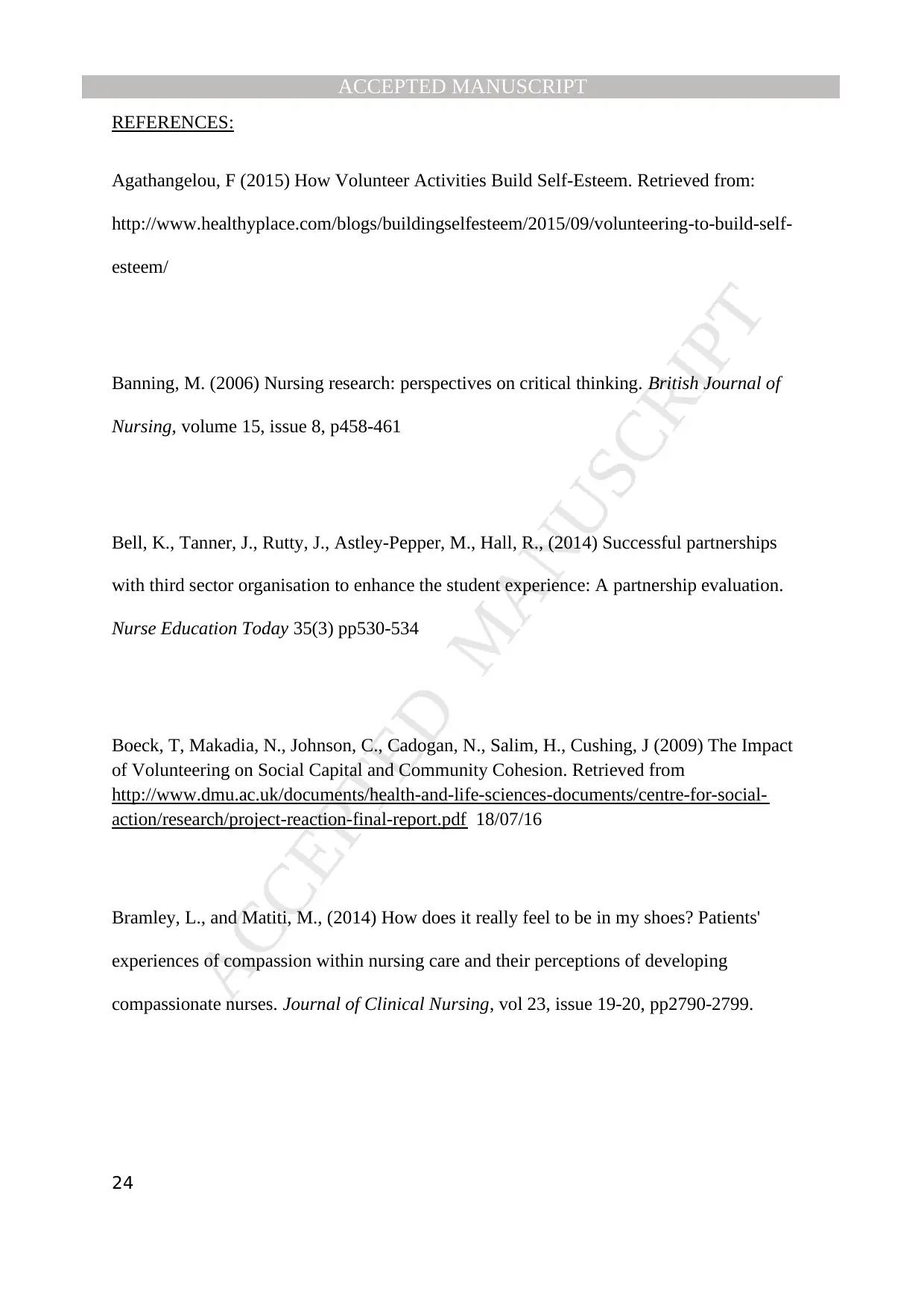
MANUSCRIPTACCEPTED
ACCEPTED MANUSCRIPT
24
REFERENCES:
Agathangelou, F (2015) How Volunteer Activities Build Self-Esteem. Retrieved from:
http://www.healthyplace.com/blogs/buildingselfesteem/2015/09/volunteering-to-build-self-
esteem/
Banning, M. (2006) Nursing research: perspectives on critical thinking. British Journal of
Nursing, volume 15, issue 8, p458-461
Bell, K., Tanner, J., Rutty, J., Astley-Pepper, M., Hall, R., (2014) Successful partnerships
with third sector organisation to enhance the student experience: A partnership evaluation.
Nurse Education Today 35(3) pp530-534
Boeck, T, Makadia, N., Johnson, C., Cadogan, N., Salim, H., Cushing, J (2009) The Impact
of Volunteering on Social Capital and Community Cohesion. Retrieved from
http://www.dmu.ac.uk/documents/health-and-life-sciences-documents/centre-for-social-
action/research/project-reaction-final-report.pdf 18/07/16
Bramley, L., and Matiti, M., (2014) How does it really feel to be in my shoes? Patients'
experiences of compassion within nursing care and their perceptions of developing
compassionate nurses. Journal of Clinical Nursing, vol 23, issue 19-20, pp2790-2799.
ACCEPTED MANUSCRIPT
24
REFERENCES:
Agathangelou, F (2015) How Volunteer Activities Build Self-Esteem. Retrieved from:
http://www.healthyplace.com/blogs/buildingselfesteem/2015/09/volunteering-to-build-self-
esteem/
Banning, M. (2006) Nursing research: perspectives on critical thinking. British Journal of
Nursing, volume 15, issue 8, p458-461
Bell, K., Tanner, J., Rutty, J., Astley-Pepper, M., Hall, R., (2014) Successful partnerships
with third sector organisation to enhance the student experience: A partnership evaluation.
Nurse Education Today 35(3) pp530-534
Boeck, T, Makadia, N., Johnson, C., Cadogan, N., Salim, H., Cushing, J (2009) The Impact
of Volunteering on Social Capital and Community Cohesion. Retrieved from
http://www.dmu.ac.uk/documents/health-and-life-sciences-documents/centre-for-social-
action/research/project-reaction-final-report.pdf 18/07/16
Bramley, L., and Matiti, M., (2014) How does it really feel to be in my shoes? Patients'
experiences of compassion within nursing care and their perceptions of developing
compassionate nurses. Journal of Clinical Nursing, vol 23, issue 19-20, pp2790-2799.
Secure Best Marks with AI Grader
Need help grading? Try our AI Grader for instant feedback on your assignments.
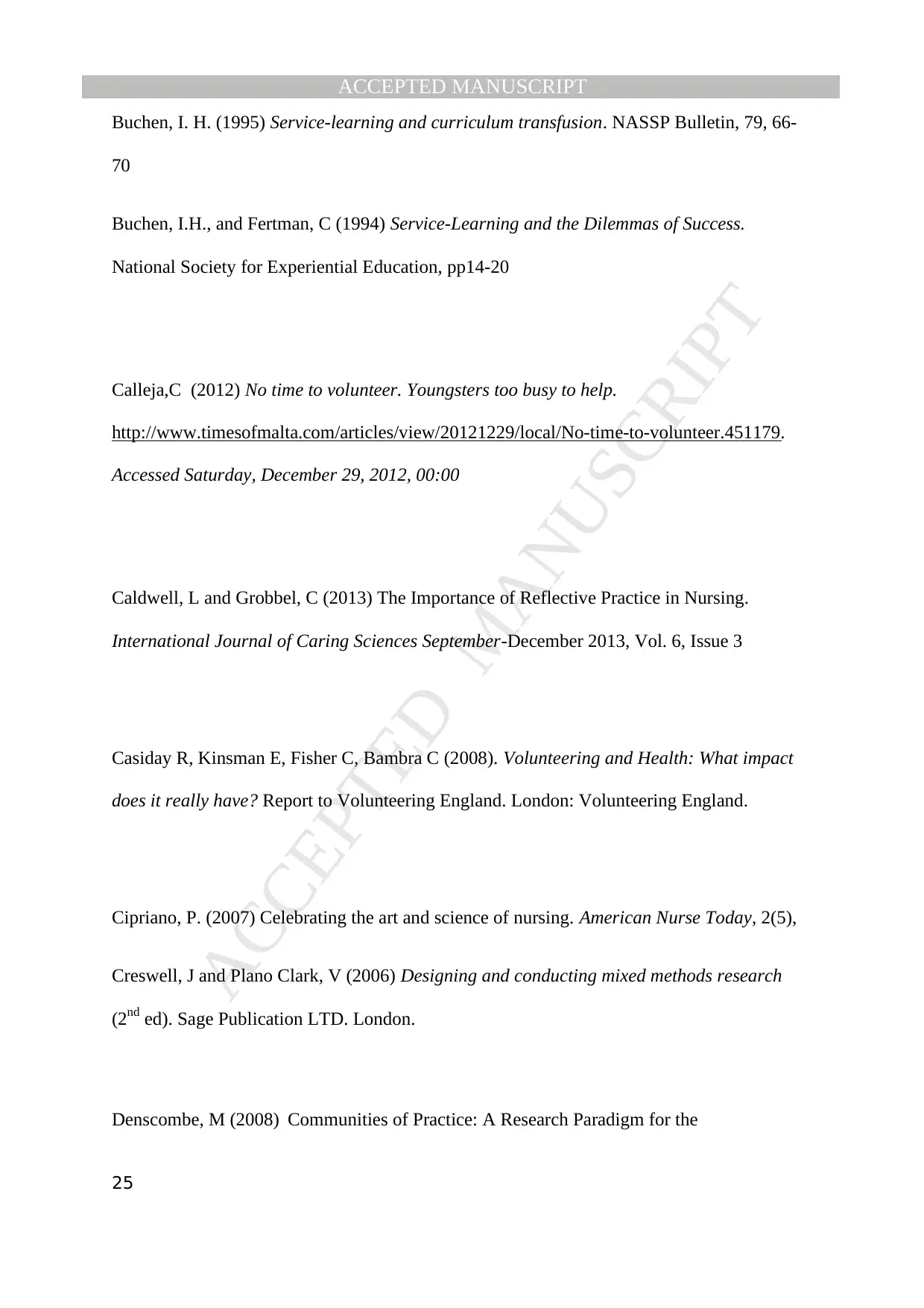
MANUSCRIPTACCEPTED
ACCEPTED MANUSCRIPT
25
Buchen, I. H. (1995) Service-learning and curriculum transfusion. NASSP Bulletin, 79, 66-
70
Buchen, I.H., and Fertman, C (1994) Service-Learning and the Dilemmas of Success.
National Society for Experiential Education, pp14-20
Calleja,C (2012) No time to volunteer. Youngsters too busy to help.
http://www.timesofmalta.com/articles/view/20121229/local/No-time-to-volunteer.451179.
Accessed Saturday, December 29, 2012, 00:00
Caldwell, L and Grobbel, C (2013) The Importance of Reflective Practice in Nursing.
International Journal of Caring Sciences September-December 2013, Vol. 6, Issue 3
Casiday R, Kinsman E, Fisher C, Bambra C (2008). Volunteering and Health: What impact
does it really have? Report to Volunteering England. London: Volunteering England.
Cipriano, P. (2007) Celebrating the art and science of nursing. American Nurse Today, 2(5),
Creswell, J and Plano Clark, V (2006) Designing and conducting mixed methods research
(2nd ed). Sage Publication LTD. London.
Denscombe, M (2008) Communities of Practice: A Research Paradigm for the
ACCEPTED MANUSCRIPT
25
Buchen, I. H. (1995) Service-learning and curriculum transfusion. NASSP Bulletin, 79, 66-
70
Buchen, I.H., and Fertman, C (1994) Service-Learning and the Dilemmas of Success.
National Society for Experiential Education, pp14-20
Calleja,C (2012) No time to volunteer. Youngsters too busy to help.
http://www.timesofmalta.com/articles/view/20121229/local/No-time-to-volunteer.451179.
Accessed Saturday, December 29, 2012, 00:00
Caldwell, L and Grobbel, C (2013) The Importance of Reflective Practice in Nursing.
International Journal of Caring Sciences September-December 2013, Vol. 6, Issue 3
Casiday R, Kinsman E, Fisher C, Bambra C (2008). Volunteering and Health: What impact
does it really have? Report to Volunteering England. London: Volunteering England.
Cipriano, P. (2007) Celebrating the art and science of nursing. American Nurse Today, 2(5),
Creswell, J and Plano Clark, V (2006) Designing and conducting mixed methods research
(2nd ed). Sage Publication LTD. London.
Denscombe, M (2008) Communities of Practice: A Research Paradigm for the
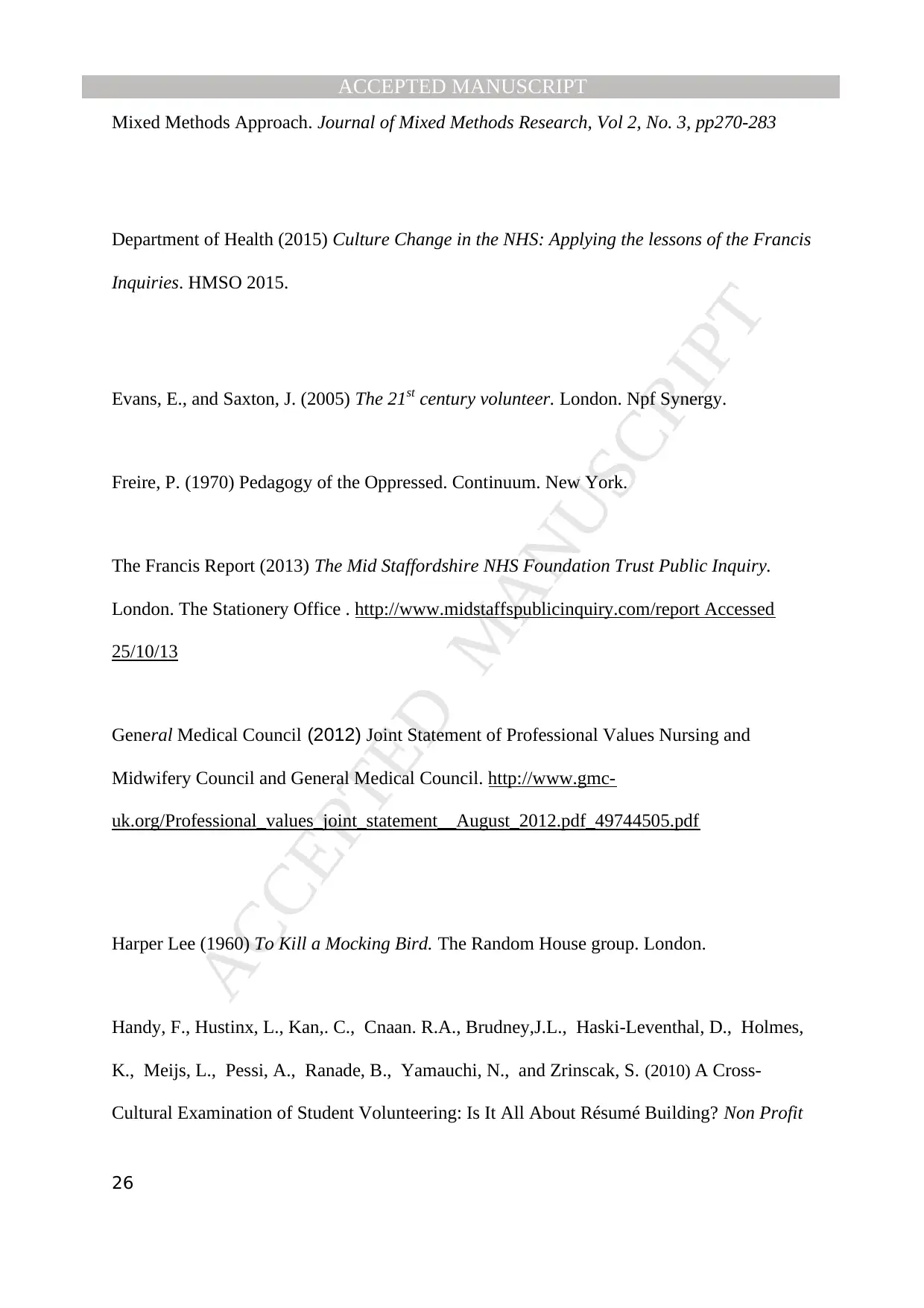
MANUSCRIPTACCEPTED
ACCEPTED MANUSCRIPT
26
Mixed Methods Approach. Journal of Mixed Methods Research, Vol 2, No. 3, pp270-283
Department of Health (2015) Culture Change in the NHS: Applying the lessons of the Francis
Inquiries. HMSO 2015.
Evans, E., and Saxton, J. (2005) The 21st century volunteer. London. Npf Synergy.
Freire, P. (1970) Pedagogy of the Oppressed. Continuum. New York.
The Francis Report (2013) The Mid Staffordshire NHS Foundation Trust Public Inquiry.
London. The Stationery Office . http://www.midstaffspublicinquiry.com/report Accessed
25/10/13
General Medical Council (2012) Joint Statement of Professional Values Nursing and
Midwifery Council and General Medical Council. http://www.gmc-
uk.org/Professional_values_joint_statement__August_2012.pdf_49744505.pdf
Harper Lee (1960) To Kill a Mocking Bird. The Random House group. London.
Handy, F., Hustinx, L., Kan,. C., Cnaan. R.A., Brudney,J.L., Haski-Leventhal, D., Holmes,
K., Meijs, L., Pessi, A., Ranade, B., Yamauchi, N., and Zrinscak, S. (2010) A Cross-
Cultural Examination of Student Volunteering: Is It All About Résumé Building? Non Profit
ACCEPTED MANUSCRIPT
26
Mixed Methods Approach. Journal of Mixed Methods Research, Vol 2, No. 3, pp270-283
Department of Health (2015) Culture Change in the NHS: Applying the lessons of the Francis
Inquiries. HMSO 2015.
Evans, E., and Saxton, J. (2005) The 21st century volunteer. London. Npf Synergy.
Freire, P. (1970) Pedagogy of the Oppressed. Continuum. New York.
The Francis Report (2013) The Mid Staffordshire NHS Foundation Trust Public Inquiry.
London. The Stationery Office . http://www.midstaffspublicinquiry.com/report Accessed
25/10/13
General Medical Council (2012) Joint Statement of Professional Values Nursing and
Midwifery Council and General Medical Council. http://www.gmc-
uk.org/Professional_values_joint_statement__August_2012.pdf_49744505.pdf
Harper Lee (1960) To Kill a Mocking Bird. The Random House group. London.
Handy, F., Hustinx, L., Kan,. C., Cnaan. R.A., Brudney,J.L., Haski-Leventhal, D., Holmes,
K., Meijs, L., Pessi, A., Ranade, B., Yamauchi, N., and Zrinscak, S. (2010) A Cross-
Cultural Examination of Student Volunteering: Is It All About Résumé Building? Non Profit

MANUSCRIPTACCEPTED
ACCEPTED MANUSCRIPT
27
and Voluntary Sector Quarterly online first, January 28th 2010.
doi:10.1177/0899764009344353
Haski-Leventhal, D. Cnaan, R. Handy, F. Brudney, J.L., Holmes, K, Hustinx, L (2008)
Students’ vocational choices and voluntary action: A 12 nation study. Voluntas, 19(1), 1-21
Health Education England (2015) Raising the Bar. Shape of Caring: A Review of the Future
Education and Training of Registered Nurses and Care Assistants.
https://hee.nhs.uk/sites/default/files/documents/Shape-of-caring-review-FINAL.pdf accessed
18/02/16
Health and Care Professions Council (2016). Standards of Conduct, Performance and Ethics.
HCPC. London.
Heaslip, P., (1993), Revised 2008 Critical Thinking and Nursing. Retrieved from
www.criticalthinking.org
Higher Education Statistics Agency (HESA) 2010/11
https://www.hesa.ac.uk/component/content/article?id=2411 accessed 18/02/16
Holdsworth,C .and Brewis, G. (2014) Volunteering, choice, and control: a case study of
higher education student volunteering. Journal of Youth Studies, volume 17, issue 2, 2014.
ACCEPTED MANUSCRIPT
27
and Voluntary Sector Quarterly online first, January 28th 2010.
doi:10.1177/0899764009344353
Haski-Leventhal, D. Cnaan, R. Handy, F. Brudney, J.L., Holmes, K, Hustinx, L (2008)
Students’ vocational choices and voluntary action: A 12 nation study. Voluntas, 19(1), 1-21
Health Education England (2015) Raising the Bar. Shape of Caring: A Review of the Future
Education and Training of Registered Nurses and Care Assistants.
https://hee.nhs.uk/sites/default/files/documents/Shape-of-caring-review-FINAL.pdf accessed
18/02/16
Health and Care Professions Council (2016). Standards of Conduct, Performance and Ethics.
HCPC. London.
Heaslip, P., (1993), Revised 2008 Critical Thinking and Nursing. Retrieved from
www.criticalthinking.org
Higher Education Statistics Agency (HESA) 2010/11
https://www.hesa.ac.uk/component/content/article?id=2411 accessed 18/02/16
Holdsworth,C .and Brewis, G. (2014) Volunteering, choice, and control: a case study of
higher education student volunteering. Journal of Youth Studies, volume 17, issue 2, 2014.
Paraphrase This Document
Need a fresh take? Get an instant paraphrase of this document with our AI Paraphraser
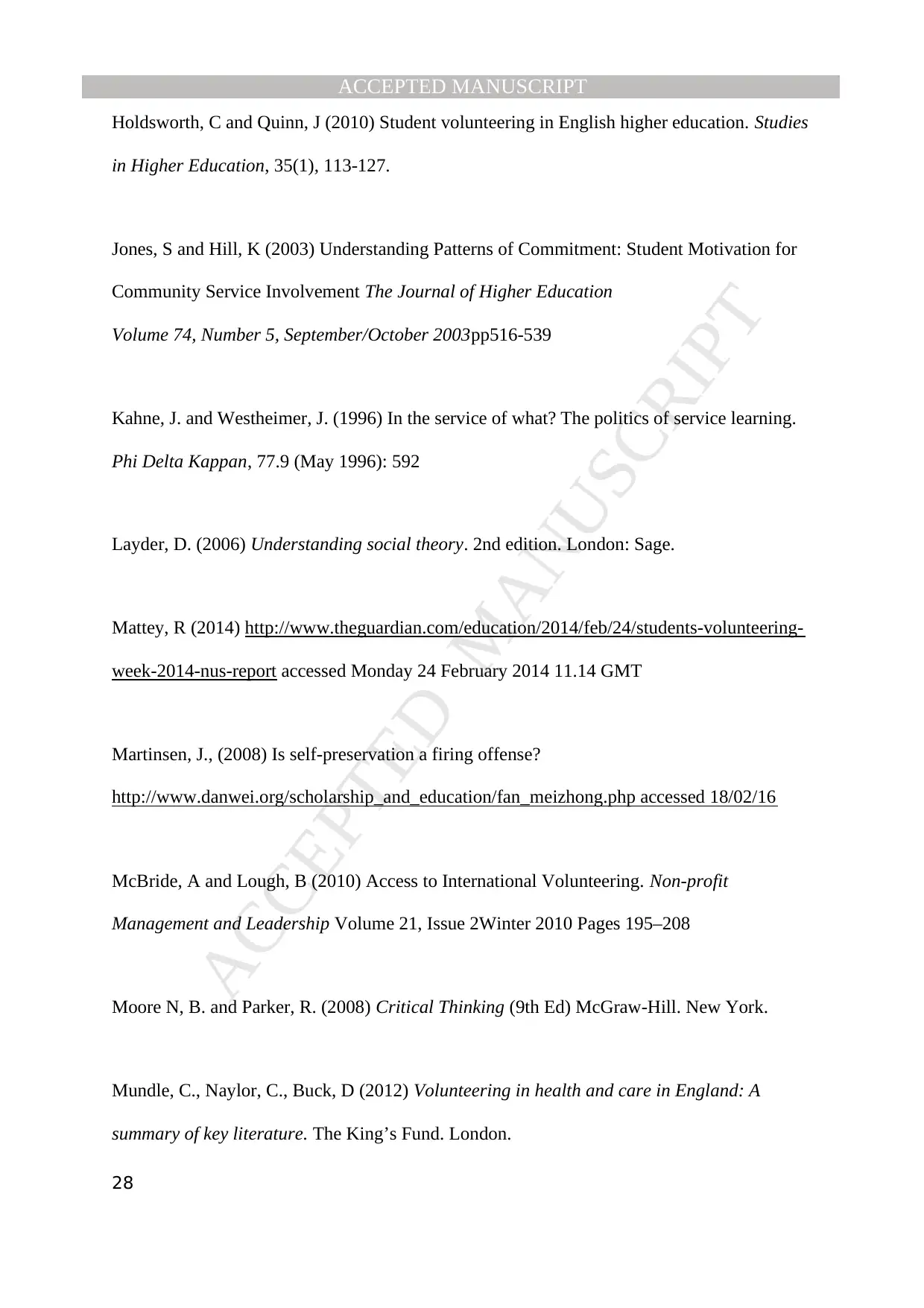
MANUSCRIPTACCEPTED
ACCEPTED MANUSCRIPT
28
Holdsworth, C and Quinn, J (2010) Student volunteering in English higher education. Studies
in Higher Education, 35(1), 113-127.
Jones, S and Hill, K (2003) Understanding Patterns of Commitment: Student Motivation for
Community Service Involvement The Journal of Higher Education
Volume 74, Number 5, September/October 2003pp516-539
Kahne, J. and Westheimer, J. (1996) In the service of what? The politics of service learning.
Phi Delta Kappan, 77.9 (May 1996): 592
Layder, D. (2006) Understanding social theory. 2nd edition. London: Sage.
Mattey, R (2014) http://www.theguardian.com/education/2014/feb/24/students-volunteering-
week-2014-nus-report accessed Monday 24 February 2014 11.14 GMT
Martinsen, J., (2008) Is self-preservation a firing offense?
http://www.danwei.org/scholarship_and_education/fan_meizhong.php accessed 18/02/16
McBride, A and Lough, B (2010) Access to International Volunteering. Non-profit
Management and Leadership Volume 21, Issue 2Winter 2010 Pages 195–208
Moore N, B. and Parker, R. (2008) Critical Thinking (9th Ed) McGraw-Hill. New York.
Mundle, C., Naylor, C., Buck, D (2012) Volunteering in health and care in England: A
summary of key literature. The King’s Fund. London.
ACCEPTED MANUSCRIPT
28
Holdsworth, C and Quinn, J (2010) Student volunteering in English higher education. Studies
in Higher Education, 35(1), 113-127.
Jones, S and Hill, K (2003) Understanding Patterns of Commitment: Student Motivation for
Community Service Involvement The Journal of Higher Education
Volume 74, Number 5, September/October 2003pp516-539
Kahne, J. and Westheimer, J. (1996) In the service of what? The politics of service learning.
Phi Delta Kappan, 77.9 (May 1996): 592
Layder, D. (2006) Understanding social theory. 2nd edition. London: Sage.
Mattey, R (2014) http://www.theguardian.com/education/2014/feb/24/students-volunteering-
week-2014-nus-report accessed Monday 24 February 2014 11.14 GMT
Martinsen, J., (2008) Is self-preservation a firing offense?
http://www.danwei.org/scholarship_and_education/fan_meizhong.php accessed 18/02/16
McBride, A and Lough, B (2010) Access to International Volunteering. Non-profit
Management and Leadership Volume 21, Issue 2Winter 2010 Pages 195–208
Moore N, B. and Parker, R. (2008) Critical Thinking (9th Ed) McGraw-Hill. New York.
Mundle, C., Naylor, C., Buck, D (2012) Volunteering in health and care in England: A
summary of key literature. The King’s Fund. London.
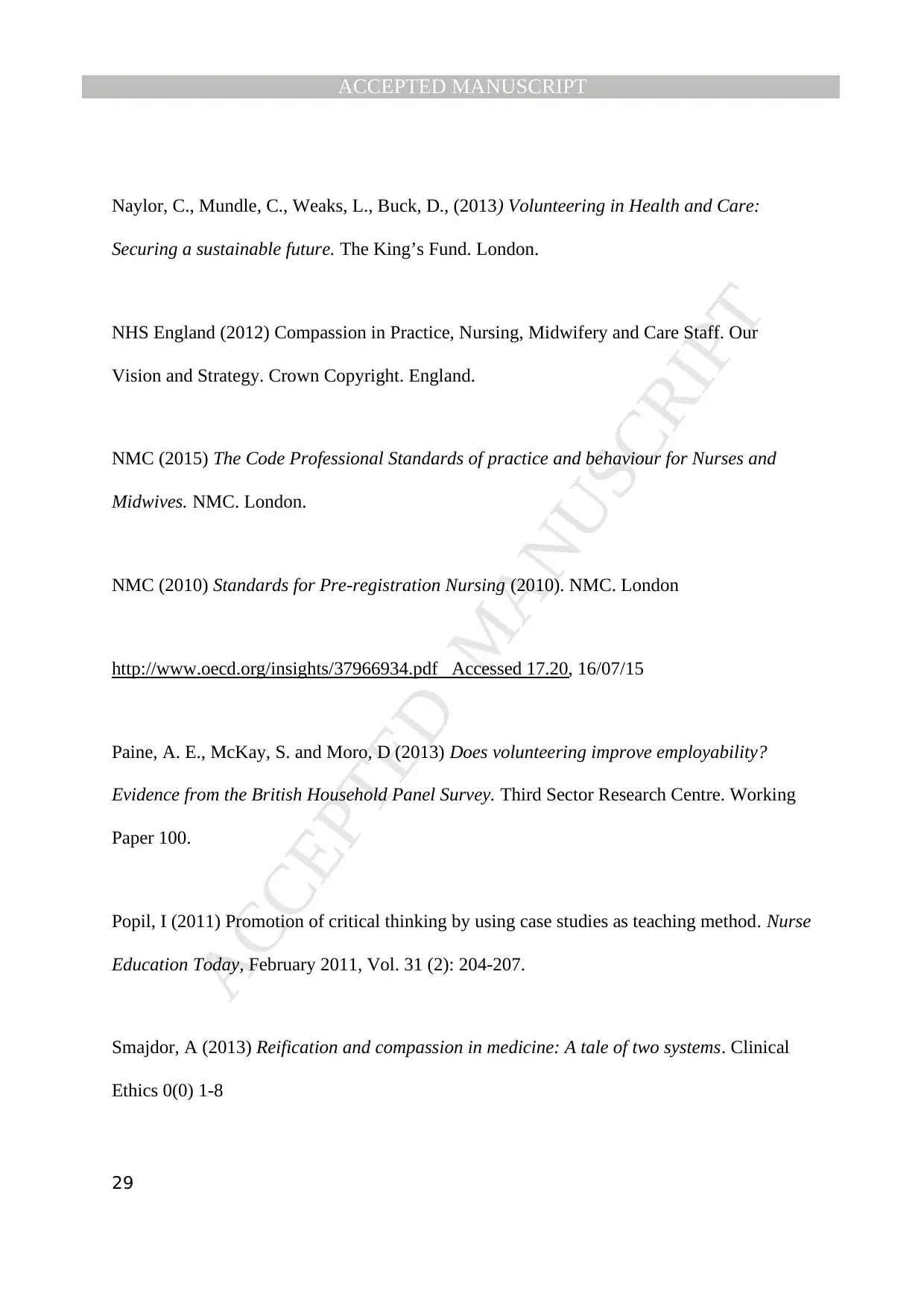
MANUSCRIPTACCEPTED
ACCEPTED MANUSCRIPT
29
Naylor, C., Mundle, C., Weaks, L., Buck, D., (2013) Volunteering in Health and Care:
Securing a sustainable future. The King’s Fund. London.
NHS England (2012) Compassion in Practice, Nursing, Midwifery and Care Staff. Our
Vision and Strategy. Crown Copyright. England.
NMC (2015) The Code Professional Standards of practice and behaviour for Nurses and
Midwives. NMC. London.
NMC (2010) Standards for Pre-registration Nursing (2010). NMC. London
http://www.oecd.org/insights/37966934.pdf Accessed 17.20, 16/07/15
Paine, A. E., McKay, S. and Moro, D (2013) Does volunteering improve employability?
Evidence from the British Household Panel Survey. Third Sector Research Centre. Working
Paper 100.
Popil, I (2011) Promotion of critical thinking by using case studies as teaching method. Nurse
Education Today, February 2011, Vol. 31 (2): 204-207.
Smajdor, A (2013) Reification and compassion in medicine: A tale of two systems. Clinical
Ethics 0(0) 1-8
ACCEPTED MANUSCRIPT
29
Naylor, C., Mundle, C., Weaks, L., Buck, D., (2013) Volunteering in Health and Care:
Securing a sustainable future. The King’s Fund. London.
NHS England (2012) Compassion in Practice, Nursing, Midwifery and Care Staff. Our
Vision and Strategy. Crown Copyright. England.
NMC (2015) The Code Professional Standards of practice and behaviour for Nurses and
Midwives. NMC. London.
NMC (2010) Standards for Pre-registration Nursing (2010). NMC. London
http://www.oecd.org/insights/37966934.pdf Accessed 17.20, 16/07/15
Paine, A. E., McKay, S. and Moro, D (2013) Does volunteering improve employability?
Evidence from the British Household Panel Survey. Third Sector Research Centre. Working
Paper 100.
Popil, I (2011) Promotion of critical thinking by using case studies as teaching method. Nurse
Education Today, February 2011, Vol. 31 (2): 204-207.
Smajdor, A (2013) Reification and compassion in medicine: A tale of two systems. Clinical
Ethics 0(0) 1-8

MANUSCRIPTACCEPTED
ACCEPTED MANUSCRIPT
30
Smith, K, Holmes, Haski-Leventhal, D, Cnaan, R, Handy, F, & Brudney, J.L. (2010)
Motivations and Benefits of Student Volunteering: Comparing Regular, Occasional, and
Non-Volunteers in Five Countries. ANSERJ Canadian Journal of Nonprofit and Social
Economy Research. Vol1, No.1, Fall/Autumn 2010, 65-81
Thomas, D.R. (2006) A General Inductive Approach for Analysing Qualitative Evaluation
Data. American Journal of Evaluation, Vol 27, No. 2 pp237-246.
ACCEPTED MANUSCRIPT
30
Smith, K, Holmes, Haski-Leventhal, D, Cnaan, R, Handy, F, & Brudney, J.L. (2010)
Motivations and Benefits of Student Volunteering: Comparing Regular, Occasional, and
Non-Volunteers in Five Countries. ANSERJ Canadian Journal of Nonprofit and Social
Economy Research. Vol1, No.1, Fall/Autumn 2010, 65-81
Thomas, D.R. (2006) A General Inductive Approach for Analysing Qualitative Evaluation
Data. American Journal of Evaluation, Vol 27, No. 2 pp237-246.
Secure Best Marks with AI Grader
Need help grading? Try our AI Grader for instant feedback on your assignments.
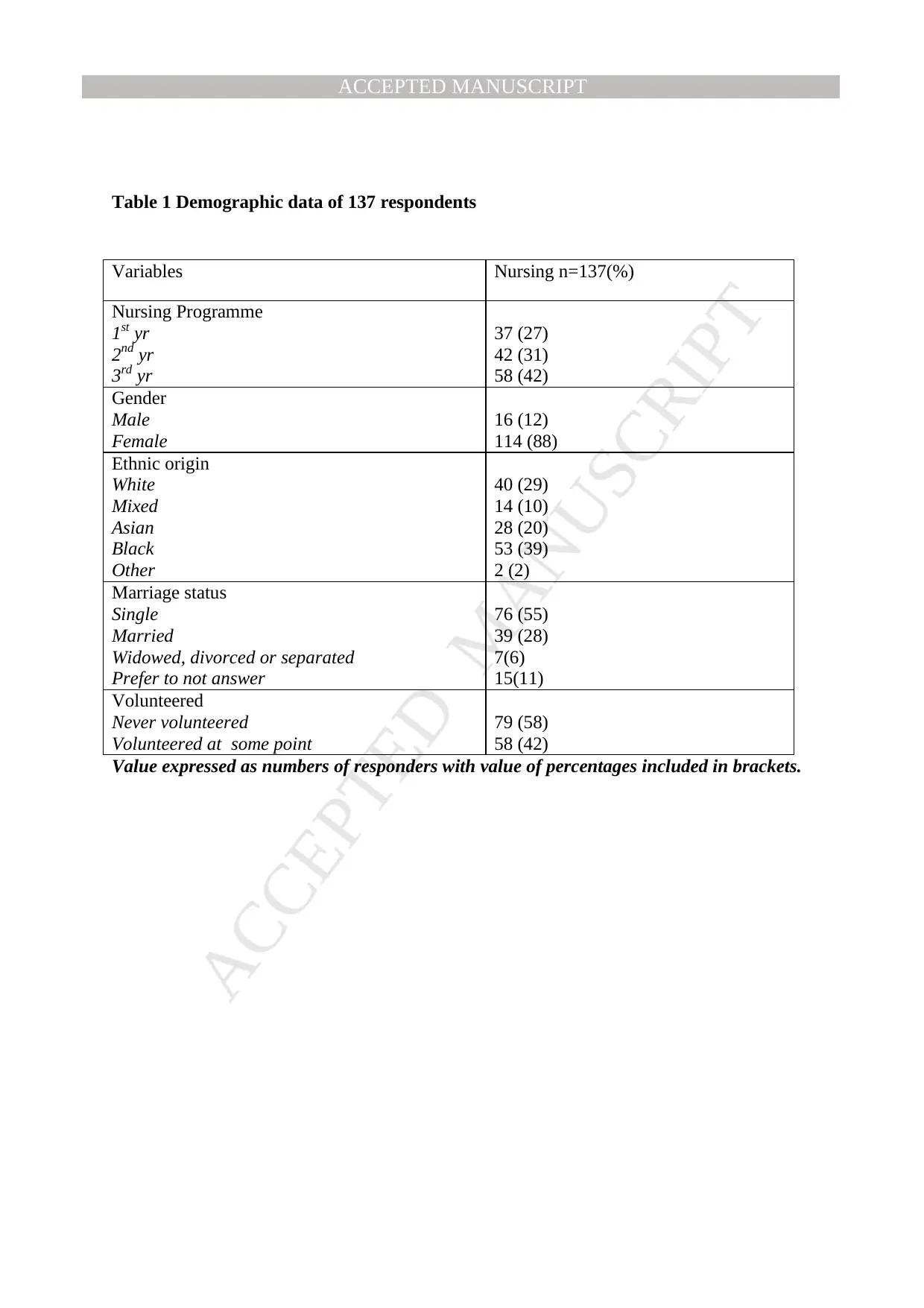
MANUSCRIPTACCEPTED
ACCEPTED MANUSCRIPT
Table 1 Demographic data of 137 respondents
Value expressed as numbers of responders with value of percentages included in brackets.
Variables Nursing n=137(%)
Nursing Programme
1st yr
2nd yr
3rd yr
37 (27)
42 (31)
58 (42)
Gender
Male
Female
16 (12)
114 (88)
Ethnic origin
White
Mixed
Asian
Black
Other
40 (29)
14 (10)
28 (20)
53 (39)
2 (2)
Marriage status
Single
Married
Widowed, divorced or separated
Prefer to not answer
76 (55)
39 (28)
7(6)
15(11)
Volunteered
Never volunteered
Volunteered at some point
79 (58)
58 (42)
ACCEPTED MANUSCRIPT
Table 1 Demographic data of 137 respondents
Value expressed as numbers of responders with value of percentages included in brackets.
Variables Nursing n=137(%)
Nursing Programme
1st yr
2nd yr
3rd yr
37 (27)
42 (31)
58 (42)
Gender
Male
Female
16 (12)
114 (88)
Ethnic origin
White
Mixed
Asian
Black
Other
40 (29)
14 (10)
28 (20)
53 (39)
2 (2)
Marriage status
Single
Married
Widowed, divorced or separated
Prefer to not answer
76 (55)
39 (28)
7(6)
15(11)
Volunteered
Never volunteered
Volunteered at some point
79 (58)
58 (42)
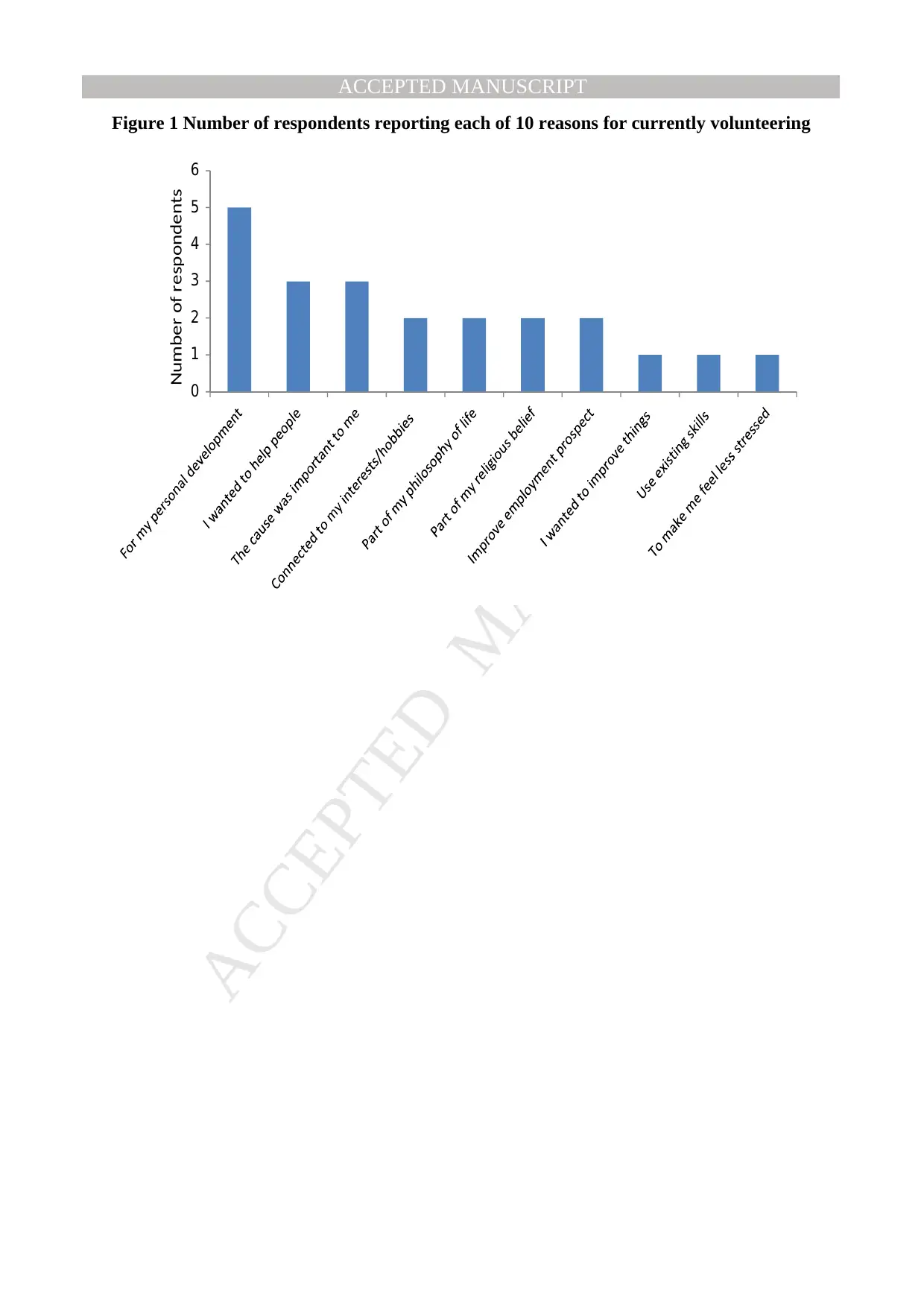
MANUSCRIPTACCEPTED
ACCEPTED MANUSCRIPT
Figure 1 Number of respondents reporting each of 10 reasons for currently volunteering
0
1
2
3
4
5
6
Number of respondents
ACCEPTED MANUSCRIPT
Figure 1 Number of respondents reporting each of 10 reasons for currently volunteering
0
1
2
3
4
5
6
Number of respondents
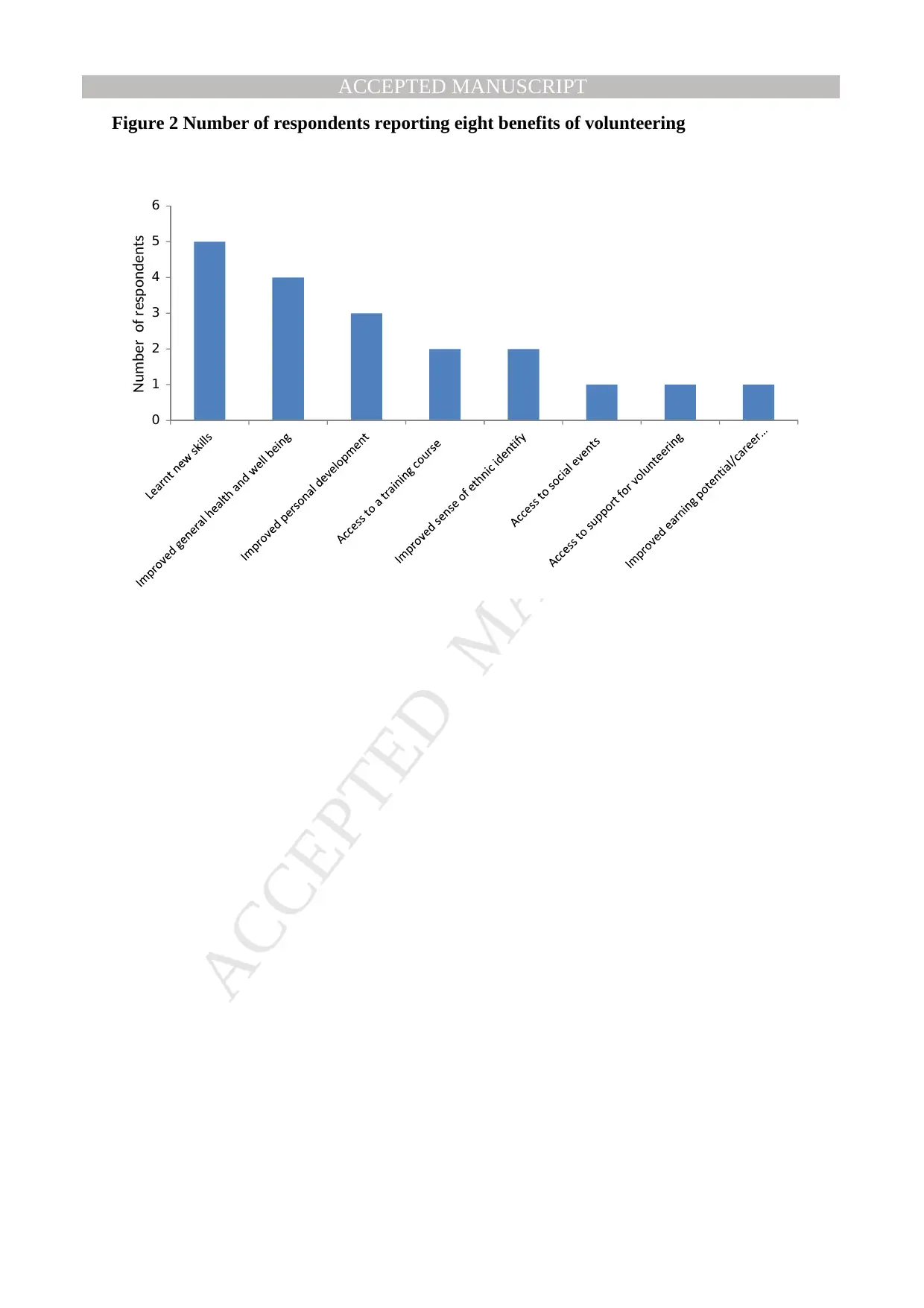
MANUSCRIPTACCEPTED
ACCEPTED MANUSCRIPT
Figure 2 Number of respondents reporting eight benefits of volunteering
0
1
2
3
4
5
6
Number of respondents
ACCEPTED MANUSCRIPT
Figure 2 Number of respondents reporting eight benefits of volunteering
0
1
2
3
4
5
6
Number of respondents
Paraphrase This Document
Need a fresh take? Get an instant paraphrase of this document with our AI Paraphraser

MANUSCRIPTACCEPTED
ACCEPTED MANUSCRIPT
Figure 3 Number of respondents reporting six reasons for not volunteering
0
10
20
30
40
50
60
70
80
90
Too little time Demands of
my course are
too great
Lack of
confidence in
volunteering
Don’t know
where to
access
information
Not sure what
skills to offer
Poor
experience of
volunteering
in the past
Number of respondednts
ACCEPTED MANUSCRIPT
Figure 3 Number of respondents reporting six reasons for not volunteering
0
10
20
30
40
50
60
70
80
90
Too little time Demands of
my course are
too great
Lack of
confidence in
volunteering
Don’t know
where to
access
information
Not sure what
skills to offer
Poor
experience of
volunteering
in the past
Number of respondednts

MANUSCRIPTACCEPTED
ACCEPTED MANUSCRIPT
View publication statsView publication stats
ACCEPTED MANUSCRIPT
View publication statsView publication stats
1 out of 39
Your All-in-One AI-Powered Toolkit for Academic Success.
+13062052269
info@desklib.com
Available 24*7 on WhatsApp / Email
![[object Object]](/_next/static/media/star-bottom.7253800d.svg)
Unlock your academic potential
© 2024 | Zucol Services PVT LTD | All rights reserved.